





Largest shareholder wants the chain to shrink new restaurants as it continues to expand
By Jack Grieve
When word got out Aug. 16 of an activist investor taking a nearly 10% stake in Portillo’s, questions surfaced around what the Newport Beach, Calif.-based investment rm had cooking for Chicago’s favorite fast-casual chain. Now we have some answers.
Engaged Capital, which has a track record of targeting restaurant operators, believes Portillo’s is in the early stages of successful national expansion and has the ability to generate industryleading cash-on-cash returns — but only if its restaurants keep getting smaller, according to a source familiar with the activist investor’s vision.
Engaged Capital wants Portillo’s to aggressively shrink the square footage of its new restaurants as it continues to expand. e brand’s longstanding Chicago-area spaces tend to be vast, some spanning two oors and up to 11,000 square feet, which is uncharacteristically
large for a fast-casual chain. Portillo’s here can justify those large spaces because the margins in Chicago remain so strong. Nationally, though, Engaged thinks less is more.
e chain has been shrinking its new storefronts for years. e company in 2023 teased a prototype, dubbed the “restaurant of the future,” calling for new spaces to be between 5,500 and 6,000 square feet.
Engaged wants Portillo’s to double down on those e orts and shrink new spaces even further. Doing so would allow the chain to save on both build-out and operating costs, the source said.
And if Engaged doesn’t get what it wants, it could push for a sale.
As Portillo’s expands, cutting back on the physical footprint is in line with broader trends in the fast-casual market, particularly as dining habits have changed since the pandemic.


Steve Cahillane is in line for a sweet payday after running Kellogg spinoff for less than a year. PAGE


And they’re off. After a forward-looking Chicago convention that was about as successful as she could ask for, Democratic presidential nominee Kamala Harris and GOP nominee Donald Trump now have officially begun a twomonth mad dash to Election Day. Expect a truly wild and woolly few weeks — early voting begins not long after Labor Day — with the hardcore in both parties convinced in their soul that the future of the country is at stake. There are any number of key issues, including the impact of tighter limits on immigration to this city of immigrants, not to mention reproductive rights and how to bring peace to the Middle East. But a few issues are of particular importance to voters in Chicago and Illinois. And in recent days, we’ve learned some things of importance about the futures of Gov. J.B. Pritzker and Mayor Brandon Johnson.
Let me start with the issues of special local importance. At the top of the list is that acronym known as SALT.

control Congress — there is an excellent shot at change. After all, Harris comes from another high-tax state, California.
A related matter at issue is whether to raise or lower the corporate tax rate, which is part of the same expiring law. Trump and Harris are Mars and Venus on this one. He wants to lower it further, and she wants to raise it.
Between CPS, still-high crime rates and a looming city budget hole in the $1 billion range, Johnson is about to enter a very, very difficult stretch.
Once upon a time, state and local taxes, aka SALT, were fully deductible on your federal income tax. But Trump signed into law a measure pushed by Republicans such as former DuPage County U.S. Rep. Peter Roskam to cap that deduction at a maximum of $10,000 per year on individual tax returns.
Republicans argued the deduction effectively forced taxpayers in low-tax states to subsidize those in high-tax states such as Illinois. Whatever the merits to that argument, the change absolutely clobbered hundreds of thousands of middle-income Illinois families, especially in Chicago suburbs, where it doesn’t take much in property and state income taxes to breeze past the $10,000 cap. Imposing the SALT cap has almost certainly been a factor in Illinois’ continuing loss of people and wealth to places like Texas and Florida.
Well, that bill is up for renewal next year. Should Trump be victorious, chances of raising or eliminating the cap are minimal. If Harris wins — and Democrats
Of equal importance to the Illinois corporate community is Trump’s plan to raise tariffs on imports across the board. He says such a step will stimulate regrowth of the domestic supply chain, particularly here in the Rust Belt. Others argue it will just raise prices and inflation. Either way, manufacturers heavily dependent on exports, such as Caterpillar and Deere, have to be concerned about the possibility of tariffs kicking off a trade war, which would hurt their business.
Another local business, electric vehicle production, also appears to be on the docket. Trump repeatedly has criticized EV mandates, subsidies and related items. That position is of keen interest to Rivian, Gotion, Stellantis, Lion and other companies in the EV space here, which have gained from big national and state subsidies, the latter thanks to Pritzker, who sees EV production as key to Illinois’ future.
Then there’s money for transportation. The Chicago Transit Authority and Metra face a financial cliff starting late next year, and though most federal transit aid is for capital and not
operations, it’s all still green and somewhat fungible. Also awaiting news is Amtrak, which has huge Chicago operations and was a beneficiary of funding from train-rider Joe Biden. Look for Democrats to be far more generous with money than Trump.
Neither Johnson’s nor Pritzker’s name will be on the ballot in November. But we’ve learned some things about each in recent days.
Pritzker has suggested he
doesn’t want a cabinet job and hinted during the Democratic National Convention he’s interested in seeking a third term as governor. Pritzker certainly would have work to do, starting with revving up an Illinois economy that, despite some recent progress, still is lagging national growth rates.
But potentially complicating his path is Johnson, who badly needs more state money now, especially
MORE: As the spotlight moves away from Chicago post-DNC, the city’s problems remain I PAGE 8
to fill a huge hole in Chicago Public Schools funding.
The Chicago Teachers Union, where Johnson once worked, as well as Johnson himself have raised the volume on their call for the state to send a big check, suggesting it’s a matter of racial equity, since most CPS students are Black or Brown. But giving them what they want — suburban and downstate schools would have to be cut in, too — would cost billions of dollars a year that the state doesn’t have and won’t have without a hefty tax increase. Keep an eye on this one. Johnson and Pritzker will “cover it up until after November,” says one political insider. “But after that, it’s war.” Johnson, meanwhile, would be well advised to watch his back, lest local leaders (especially in the business community) take a page from national Democratic Party leadership that sent Biden packing when he trailed in the polls, as Johnson now does. I hope the mayor enjoyed addressing delegates from several other states during the convention. Between CPS, still-high crime rates and a looming city budget hole in the $1 billion range, Johnson is about to enter a very, very difficult stretch with his own re-election race just two years away. The spotlight will be gone. But not Chicago’s problems.


“It’s the partnership that matters.”
BART VITTORI – CHIEF FINANCIAL
LINZ



Years of declining admissions and underfunding at colleges have taken a toll, with the state ‘at the epicenter of this tsunami that is about to hit higher education’ I
By Brandon Dupré
Illinois’ public universities are on shaky ground, and their financial troubles may only get worse.
Years of declining enrollments, combined with a decade-plus of state underfunding, are finally coming to a head in Illinois as some public colleges are staring down gaping budget deficits with no quick and easy fixes in sight.
Northern Illinois University recently reported a $31.8 million deficit for fiscal year 2024, while Western Illinois University is laying off 124 faculty and staff to help close a $22 million deficit. Southern Illinois University Carbondale is expecting to report a $14 million deficit, according to its early projections, and Chicago State University and Northeastern Illinois University are still managing the fallout
See ENROLLMENT on Page 26
Undergraduate enrollment in Illinois has decreased by over 20% since 2014, equating to 144,000 fewer students.
$81.4 million
steve Cahillane is in line for a sweet payday after running the snack-making Kellogg spinoff for less than a year
By Ally Marotti
With Snickers maker Mars’ plan to buy Kellanova for nearly $36 billion, the CEO of the Chicago-based Pop-Tarts maker is in line for a payday that could top $81 million.
Kellanova CEO Steve Cahillane said he will exit the business after the deal closes, which is expected in 2025. Kellanova’s last proxy statement spelled out the compensation Cahillane would receive if he was terminated with a change of control. Factoring in the $83.50 per share in cash Mars plans to pay for Kellanova, Cahillane’s exiting payday will be almost $81.4 million.
“It’s a big payout, but the performance has been pretty amazing,” said Mark M. Reilly, managing director at executive search and compensation consultant Overture Alliance. “In part, that supports sort of an extraordinary payout.”
It’s been less than a year since Kellanova, which makes Cheez-It crackers, Rice Krispies Treats and other global snacking brands, split from cereal stalwart Kellogg. The thesis behind the split was that the fast-growing snack brands could unlock more value for shareholders if peeled away from mature cereal brands such as Froot Loops and Frosted Flakes. The theory has proved accurate. Since the split, the newly named Kellanova has generated sales growth and grown margins while investing in its brands. It beat second-quarter earnings estimates and recorded a 4% in-
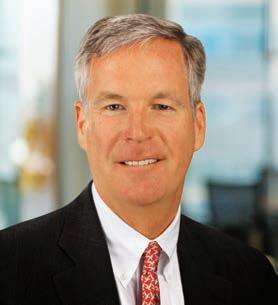
crease in net sales. Kellanova’s stock increased 33% this year through close on Aug. 13, the day before the deal was officially announced. News outlets had been reporting that the two companies were in acquisition talks the past several weeks.
For Mars, buying Kellanova is a way to penetrate deeper into grocery store snack aisles in the U.S., and tap into growth potential abroad. Illustrating how mouth-watering those prospects were to Mars: Its offer to pay $83.50 per share in cash for the Eggo maker is a 44% premium on Kellanova’s 30-day trading volume.
Selling the company to Mars was not part of the plan when Kellogg decided to split up, Cahillane said in a recent interview on CNBC’s “Money Movers.” He said Mars initiated the deal.
“When you’re a publicly traded company, you’re for sale every
See
on Page 27
By By Mark Weinraub
Private-equity firms are continuing to put big money into the manufactured housing sector even as the U.S. government is looking for ways to keep rents down in an area seen as a key provider of affordable housing.
Chicago’s Monroe Capital recently became the latest firm to enter the space, which is seen as offering investors the potential for high returns in an otherwise sluggish market for commercial real estate.
The firm announced a deal earlier this month with ECN Capital unit Triad Financial Services to
provide about $300 million for owners of manufactured housing parks looking for mortgages. The deal will provide financing for about 2,000 homes.
“Instead of a consumer buying it, it is an institution that is buying it, usually like a (real estate investment trust) or a family office,” said Kyle Asher, managing director and co-head of alternative credit solutions at Monroe Capital. “We liked that from a risk perspective.”
The number of factory-built homes backed by private equity have been rising for the past 20 years. The latest data from the Chicago-based Private Equity
Stakeholder Project, or PESP, an industry watchdog, showed 11 private-equity firms own 1,114 manufactured housing parks in the U.S., accounting for about 243,000 lots.
Private-equity ownership in the industry rose to 23% in 2021, up from 13% just two years earlier, the project found.
Big public companies like Equity LifeStyle Properties, a Chicagobased REIT founded by the late billionaire Sam Zell in 1992, have led the industry for a long time. But the market is still fragmented, with many smaller investors

Spaces is moving from Bucktown to a revamped loft office building along the North Branch of the river
By Danny Ecker
A Chicago developer that's been betting on single-family houses for rent is moving to a new home itself near Goose Island and tripling the size of its office.
Core Spaces, a student-housing developer that has expanded in recent years into the build-to-rent home sector, has signed a longterm lease for 36,000 square feet in the loft office building at 1400 N. Kingsbury St. on the city's North Side, the company confirmed. Core Spaces will move to the three-story property along the North Branch of the Chicago River early next year from Bucktown, where it has an expiring lease for about 12,000 square feet at 1643 N. Milwaukee Ave.
The office expansion stands out at a time when many companies are shrinking their workspace, embracing the remote work trend that was accelerated by the COVID-19 pandemic. While downsizing companies have cost landlords dearly and driven the local office vacancy rate to an all-time high, Core Spaces is recommitting to inperson work with a new office that its executives hope will encourage people to show up.
Working face-to-face in Bucktown has been key to building's Core Spaces' company culture, and the new office "is a big part of reinforcing that," said Joe Gatto, managing director at the Chicago-based firm. The company has grown its Chicago-area headcount to nearly 200 today, "and we really needed to provide people with more space based on how much we've grown and how

much (employees) need to be in the office," he said. Most of the company's staff works from the office four or five days a week, Gatto said.
Core Spaces went hunting for new workspace in a neighborhood rather than downtown, sacrificing the ease of public transportation access in the heart of the city for a pocket of the North Side that could give it more space in a similar environment to what it has today.
That approach ultimately helped notch a win for R2, the Chicago developer that partnered with its joint-venture owner Goldman Sachs to turn the Kingsbury building into modern office space. Among other im-
provements, the duo added a new riverwalk on the western edge of the building overlooking the "Wild Mile" stretch of the North Branch that the city of Chicago improved and rebranded to encourage recreational users.
Core Spaces joins Leapfrog Brands as an office tenant in the building, which is now roughly 75% leased, according to R2. Printer's Row Coffee opened a shop in the building earlier this summer.
R2 and Goldman Sachs bought the property and an adjacent parking garage in 2015 for $6.7 million. The developer converted the garage portion into a 40,000square-foot REI store, which it sold earlier this year to a Califor-
nia investor for $20 million.
It's unclear how much money the owners spent revamping 1400 N. Kingsbury, but the investment has paid off with new deals inked amid a tough leasing environment, R2 Principal Matt Pistorio said.
"We believe in this (creative office) asset class. Because we spent that money, we were able to attract quality tenants like Core Spaces," he said.
R2 has redeveloped a slew of former industrial properties on nearby Goose Island into offices and other uses, a strategy supported by a 2017 zoning change by the city to allow new commercial uses on a 760-acre swath of the formerly industrial North
Branch of the river. One of its highest-profile projects is the former Morton Salt warehouse between the river and Elston Avenue, which R2 helped convert into a mixed-use entertainment venue known as the Salt Shed.
Core Spaces grew out of the great financial crisis and became a prominent player in building and owning student-housing properties, which became one of the hottest commercial real estate sectors in the years following the crash.
The company today owns or manages 64 student-housing properties nationwide.
Core Spaces more recently has ventured into communities of build-to-rent homes, betting on growing demand from millennials raising families and preferring to rent rather than own homes. The company has developed two such communities to date outside Dallas and Nashville and has another 3,000 homes across 14 communities in its development pipeline, according to a spokeswoman.
The developer ran into a roadblock locally last year in an effort to build another build-to-rent community on the vacant former Scott Foresman office campus in Glenview. Core Spaces proposed buying the property from an R2led venture that foreclosed on the property and building 140 rental homes. But that $85 million project was shot down by Glenview residents and planning officials, some of whom argued the plan was too dense.
Pistorio and Abby McFadyen of leasing agency Madison Rose brokered the lease with Core Spaces.
By Rachel Herzog
A New York investor has surrendered a Magnificent Mile retail property to its lender after facing debt trouble and key tenant departures.
Ashkenazy Acquisition handed over the 52,000-square-foot retail space at 625 N. Michigan Ave. to Barings via a deed-inlieu of foreclosure in June, according to Cook County property records. The property is saddled with $61 million in debt and is likely worth less than that.
The landlord reportedly defaulted on the loan in 2023. Barings took control of the space and prepared to put it up for sale in 2023, but it never traded.
Ashkenazy isn’t the only landlord to face the fallout from the Mag Mile shopping corri -
dor’s struggles. Retail on the North Michigan Avenue strip has hovered around 30% since the onset of the COVID-19 pandemic amid lower foot traffic due to the remote work movement as well as real and perceived problems with crime.
Next door, the retail property at 605 N. Michigan Ave. traded at a steep discount earlier this month. The former owner of Water Tower Place turned the vertical mall over to its lender in 2022, and an investor in the Shops at North Bridge mall handed its stake over to a partner for a $28 million loss.
“Many landlords on Michigan Avenue have given back the keys, but we’re bullish on the Chicago suburbs, which is why we recently purchased Gateway Centre,” a spokesperson for Ashkenazy Acquisition said in a

statement. A representative for Barings declined to comment.
Ashkenazy paid $22 million
for the Gateway Centre, a 200,000-square-foot shopping center on the city’s Far North
Side near suburban Evanston, in 2023. The firm’s other Chicago holdings include retail properties at 700 N. Michigan Ave. and 25 E. Oak St.
The retail space at 625 N. Michigan Ave. is mostly vacant, having lost tenants Coach and Timberland. The sole remaining retail tenant, Garrett Popcorn, occupies about 1,500 square feet, according to real estate data provider CoStar Group.
Ashkenazy owns just the retail space on the lower floors of the 27-story tower at 625 N. Michigan Ave. A joint venture of CIM Group and Golub owns the rest of the building, which is not encumbered by the Barings debt.
Industry publication The Real Deal Chicago was the first to report on the property being handed over to the lender.

the property was built on a vacant lakefront lot in 2020 and is being sold by the esta te of its late owner for the second-highest asking price in town I
Ablufftop mansion in Lake Forest built four years ago with a rare amenity for the North Shore, a beach house down by the Lake Michigan shoreline, went up for sale at $11.9 million, the secondhighest price in town.
Tom Fuller, the former owner of a metal and plastic parts firm who had a second career as a rock ‘n’ roll musician, built the house, roughly 11,400 square feet on about 2.1 acres on Bluffs Edge Drive, in 2020. He died in March and his estate put the property, known as Rockland, on the market earlier this month, represented by Houda Chedid of Coldwell Banker Realty.
“Tom expected to have another 20 years in that house,” said Jordan Kozer, a friend and Fuller’s drummer, who’s the trustee of Fuller’s estate. “He built it to be there because he loved the water.”
Chedid said Fuller “missed nothing building this. He wanted perfection.”
The mansion, designed by the Lake Geneva firm McCormack & Etten Architects in a style that evokes New England coastal homes, has eight bedrooms, including the primary in its own dedicated wing, four fireplaces, a meditation room and an elevator.
A funicular, or miniature hillside rail line that seats four adults, runs down the bluff to the sandy beach. The beach house has a full kitchen, two baths, an enclosed porch and a living room, as well as boat storage, Chedid said.
Fuller paid $2.75 million for the site in 2014, according to the Lake County Recorder. The previous home had already been demolished, Chedid said. “We
By Dennis Rodkin
don’t usually have vacant land on the lake in Lake Forest,” she said. “He wanted something to build a new house on.”
Crain’s couldn’t determine what Fuller spent to build the house and beach amenities.
Kozer said Fuller, who grew up in Hinsdale and used to live in Lake Geneva, “fell in love with Lake Forest and wanted to live there.” Around the time he finished building the house, Fuller sold his Lake Geneva home, designed by the same architecture firm, for $5 million.
On the Bluffs Edge property, the $11.9 million price tag is Lake Forest’s second-highest asking price, after the nearly $13 million that a former Motorola executive is asking for an extensively restored 1914 mansion two miles north. They’re both vying to be Lake Forest’s highest-priced sale since the home of the late Nancy Hughes, widow of moviemaker John Hughes, sold for almost $13 million in November 2022.
There’s also an estate in the next town north, Lake Bluff, on the market for nearly $20 million. If any of them sell soon, they’ll be the year’s first Chicago-area home sale at $10 million or more. In 2023, there were four sales at that level, three of them by this point in the year, and in 2022, there were nine sales at $10 million or more, a record.
Fuller, who founded the plastic and metal components firm Fullco in 1986 and sold it for an undisclosed amount in 2021, was a self-taught musician who began writing music in 1998. He formed the Tom Fuller Band and recorded four albums between 2005 and 2014. His online bio says the band performed with Ted Nugent, Little Feat, Blue Oyster Cult and others.








As part of a five-year deal, agents will now offer customers benefit and insurance products from Portland, Ore.-based the standard
By Jon Asplund
Allstate will sell its employer voluntary benefits business to StanCorp Financial Group (The Standard) for $2 billion, the company said in a press release on Aug. 13.
The Northbrook-based insurance giant said the sale was the first in a strategic plan to find other companies to take on the business of its health and benefits holdings.
The $2 billion sale represents 20.6 times earnings from the last 12 months, which compares favorably with recent transactions, and will generate a financial book gain of about $600 million for Allstate and increase deployable capital by $1.6 billion, Allstate Chief Financial Officer Jess Merten said in an Aug. 14 call with investors.
The insurer is looking to combine its three health and benefits businesses — employer voluntary benefits, individual and group health — with companies that have additional health and benefit capabilities, while Allstate focuses
on increasing market share in its property-liability business, CEO Tom Wilson said on the call.
Wilson added the alignment between Allstate’s product offerings, employer relationships, distribution and talent and The Standard’s group benefits business "will provide customers with broader protection and higher value."
As part of the deal, Allstate agents will now offer customers benefit and insurance products from Portland, Ore.-based The Standard, in a five-year exclusive distribution arrangement, he said.
Dan McMillan, president and CEO of The Standard, said in a press release that there are "significant synergies between Allstate’s industry-leading supplemental and voluntary life products and The Standard’s expertise in workplace benefits."
In the first half of 2024, Allstate's employer voluntary benefits subsidiaries had revenues of $535 million, adjusted net income of $45 million, and statutory capital and surplus of $255 million.
Merten, Allstate's CFO, said All-



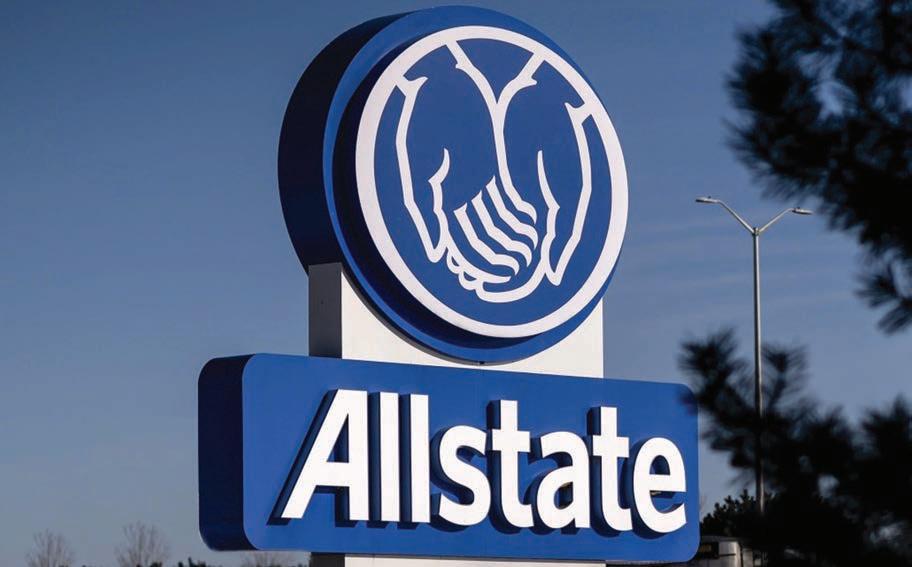
state's adjusted net income return on equity will decline by about 100 basis points following the sale, which is expected to close in the first half of 2025.
The company had considered selling all three business to one company, Wilson said, but found it better to shop them individually.
Discussions of the sale of the individual and group health business-
es, either together or separately, is continuing, Wilson said.
Overall, the health and benefits segment represents 4% of Allstate’s total 2023 revenues through the three businesses, the company said in an investor presentation as part of the Aug. 14 call.
The employer voluntary benefits business provides voluntary benefits and health products
through employers including life, accident, critical illness, and hospital indemnity protection to 3.6 million policyholders.
Individual health provides shortterm medical coverage and medicare supplemental insurance, while group health provides stoploss and fully insured group health protection to small businesses, the presentation said.







Working to




advance racial equity and economic mobility for the ne xt generation in the Great Lakes region.

Even though the just-concluded Democratic National Convention didn’t quite deliver the full economic pop that local restaurants and hotels were hoping for, the event was a win for Chicago in an esoteric and yet important way: It showcased the city’s beauty, its character and its people.
Yes, there were some protesters on the streets. Yes, there were some arrests. But those dustups were nothing like the violence that rocked the 1968 convention, the memory of which still loomed over event planners and security officials despite a relatively peaceful 1996 DNC that apparently wasn’t enough to fully dispel the ghosts of Grant Park rioters.
With discord over the Israel-Hamas conflict hanging in the air — not to mention a recent assassination attempt on Republican nominee Donald Trump — the city was hunkered down with a massive security presence. Yet violence of a scale to match the police presence never materialized. Instead, visitors were treated to a city eager to put its best foot forward, as delegates hit the afterparty circuit, savored our world-class cuisine and bopped to music by homegrown artists. Television viewers, meanwhile, got glimpses of our glittering skyline. For a city in serious need of an image makeover, the week under the intense glow of the national spotlight was a PR success.
Now that we’ve shaken the confetti out of our hair and popped the last balloon, however, it’s important to remember why

Chicago’s image was scuffed up to begin with — challenges that a week of positive press can’t undo.
In other words, now the hard part starts. While the Democrats exit Chicago to take their case for Kamala Harris nationwide — and Trump fights his battle to return to the White House — reliably blue Illinois will precipitously fade from each campaign’s mind, replaced by the all-important swing states.
And yet, the city and the state still have major problems to solve.
The biggest of them, at least measured by dollars and cents, is the crisis of underfunded public employee pensions, a balland-chain that continues to weigh down our state finances and remains the worst pension gap in the nation.
Similarly, the Chicago region’s public transit systems face a steep fiscal cliff recently reckoned to be roughly $730 mil-
lion that’s expected to hit sometime after 2025. A proposal to reform and streamline our transit agencies to cut bloat and centralize decision-making has met with resistance from — no surprise — the people who currently preside over the status quo. Can a compromise be reached? The answer to that will depend, at least in part, on the leadership of Gov. J.B. Pritzker and Mayor Brandon Johnson, who kept up friendly appearances while the good vibes of the DNC prevailed but otherwise haven’t exactly seen eye to eye on a number of issues.
One such disconnect pertains to public school funding. Johnson as well as his former employer, the Chicago Teachers Union, have pushed hard for more state funding of Chicago Public Schools. But giving them what they want will cost billions of dollars a year that the state doesn’t have and won’t have without a hefty tax increase. As one political observer put it to Crain’s Greg Hinz in an Aug. 23 column, Johnson and Pritzker will keep their disagreements under wraps until after November, but “after that, it’s war.”
The budgetary pressure on Johnson will only increase as he faces a looming budget hole in the $1 billion range and he hunts for answers to a crime problem that has reduced Chicagoans’ quality of life and tarnished the city’s reputation. The afterglow of the convention can only do so much to ease the pain caused by the violence in the city’s streets.
Rome wasn’t built in a day, and neither was the Chicago skyline beloved around the world. It took thousands of talented people, millions of work hours, the vision of architects, and the skills of engineers and workers to transform a sketch into the scenic vista we enjoy today. At the heart of this grand project is American steel, providing the literal frame for the city of Chicago that houses thousands of innovative businesses that make this city what it is.
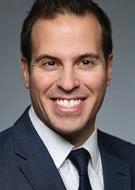
Brian
Raff is vice president of the American Institute of Steel Construction and leads the association’s sustainability efforts.
But the role of steel in building the Chicago skyline we see today wasn’t preordained — it was born in tragedy. The Great Chicago Fire of 1871 leveled the city, precipitating the need for rapid reconstruction of fireresistant buildings. The steel frames that became the basis of the first skyscrapers provided strength, durability and resistance to fire, as well as an adaptable material that gave architects the scope to both literally and figuratively reach for the sky. The first skyscraper in the world was built here in Chicago in 1885, a half-century before New Yorkers built their own. The Willis
Tower, Inland Steel building and other icons of the Loop use steel frames that have defined our city’s skyline for the last century. Chicago’s past is deeply intertwined with steel, and yet recently, it has become fashionable to push mass timber as a building material for Chicago’s urban development. This would be a mistake. Independent reading of the facts shows the extent to which mass timber’s sustainability is exaggerated by producers and protimber architects. For instance, carbon footprint figures commonly cited by the wood industry do not take into account the carbon released by the 64% of a tree’s biomass that is simply left to decay after harvesting; only 36% of that tree actually makes it into a column or beam, according to The Wilderness Society.
Informed design and construction decision-making relies on accurate numbers, and every decision matters — we are leaving both this city and this planet to our children. The steel industry’s significant reductions in carbon emissions have been independently verified and celebrated.
Since 1990, the American steel industry has reduced its emissions by 36%, seven times what was prescribed by the Kyoto Protocol, and Illinois’ senators are now at the forefront of granting millions to businesses around Illinois and Chicago for the further development of green technology in steel. Conversely, steel is an indefinitely recyclable building material which allows for the extension of its life cycle. In fact, the average new steel beam that comes out of an American mill today consists of 93% recycled appliances, cars, and steel from decommissioned buildings and bridges. The steel in a building from the 20th century can be reused in the 21st, 22nd and beyond — over and over again, with no loss of properties. Chicago’s past is the literal foundation of its future.
to provide a frame they can depend on. Steel is a versatile material as well as a sustainable one, and this makes it the optimal choice for architects looking to redefine the landscape with striking constructions with lasting aesthetic appeal.
Steel continues to be a versatile building material that can be used in innovative ways by architects to reimagine downtown
Steel continues to be a versatile building material that can be used in innovative ways by architects to reimagine downtown Chicago.
The refurbishment and revitalization of the Thompson Center mirrors the suggested design for the new Bears stadium. Both projects have similar appearances and use the same construction material — steel, because of its sustainability and strength. Architects who are looking to realize different visions for buildings with different purposes find themselves relying on steel
Chicago. Beyond the aesthetic appeal, steel is more durable, recyclable and sustainable than other building materials — a breadth of strengths that made it the material of choice in the past and the one that should guide us in the future.
Chicago’s skyline of American businesses is iconic, and the landmarks of our city were built with American steel. As we picture the Chicago skyline of the future, steel should remain the sustainable building material of choice.
When it comes to tax breaks meant to create jobs, Illinois can’t get it right.
Administrations Republican and Democratic spend way too much on too few companies. They spend too little on public systems that make a place “sticky” for promising employers. They fail to watch the “candy store” to ensure results. Then they struggle with structural budget deficits.

Greg LeRoy, who lived in Illinois for 25 years, directs Good Jobs First, a nonprofit watchdog group on economic development incentives.
For four decades, the state has granted huge incentive “megadeals” to individual companies, like the two it gave Sears totaling about $1 billion in today’s dollars — and we all know how that worked out. It radically changed how it taxes corporate profits, at the behest of big manufacturers, only to see the state lose hundreds of thousands more factory jobs.
Illinois deregulated its tax increment financing (TIF) program so that schools districts and local governments now lose about $2.3 billion a year to TIF districts. It allowed a costly program, Economic Development in a Growing Economy, or EDGE, to fail mandated reporting for 20 years — and then extended it It has three major programs that allow corporations to keep their employees’ state personal income tax payments — terrible tax policy.
Illinois and localities have given Amazon.com at least $732 million for 17 warehouses — even though the company had to build them for rapid delivery (and e-commerce simply grows at the expense of store-based retailers, like Sears).
The state enacted virtually automatic tax breaks for new data centers that routinely employ just 20 or 30 people each but are now costing the state more than $370 million a year. That program’s cost alone rose 628% last year.
When five huge federal stimulus bills sent the state $54 billion for myriad COVID-recovery purposes, Illinois was prone to using the onetime money to plug ongoing obligations — next to worst among the 11 biggest states, said a prominent budget think tank.
By one official tally, Illinois spends $17 in foregone tax revenue for every $1 it appropriates for jobs. That dated ratio is far higher now because of Gov. J.B. Pritzker’s $1.5 billion-plus in recent commitments on electric vehicles, quantum computing and microchips.
Spending through the tax code means less legislative oversight, less control over spending and far less public awareness.
Illinois still fails to require cities, counties and school districts to use Generally Accepted Accounting Principles (GAAP), so the revenues lost to local tax abatements are often undisclosed. Hidden
costs include TIF — plus local sales tax revenues lost to data centers because the state’s exemption makes it automatic.
It’s impossible to have an honest cost-benefit debate when so many costs remain hidden.
These past errors have everything to do with the state’s fiscal woes. Reversing them would create more jobs and help sustain the state’s financial recovery.
Instead of composting this ruinous history, however, Illinois is once again putting too many eggs in very few baskets: $633 million
for Rivian, the electric vehicle company that lost more than $5 billion last year; and $200 million for PsiQuantum, a young computing company with aspirational technology and just 154 jobs pledged.
Illinois should restructure its programs for microchips and electric vehicles. Reduce its risk in quantum computing. Re-regulate TIF to its better-targeted origins. Fix its corporate income tax formula that grossly favors a handful of multinational manufacturers. Terminate the EDGE program and

data center tax exemptions. Stop subsidizing e-commerce.
Illinois should invest more in STEM education, K-14. Upgrade state university engineering pro grams and entrepreneurship train ing. Prioritize assistance that ben efits promising clusters of young companies, such as process tech nology adoption, export promo tion or customized training — i.e., strategic eggs sprinkled among many employers.
Absent these reforms, Illinois is steaming to revenue icebergs ahead.





Recognize a leader at a health care organization involved in expanding health care business, service or technology.







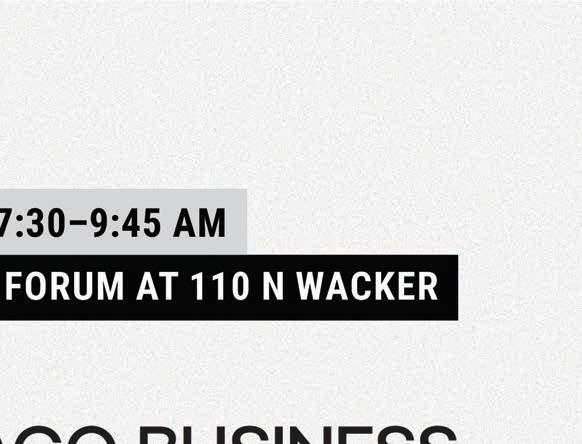




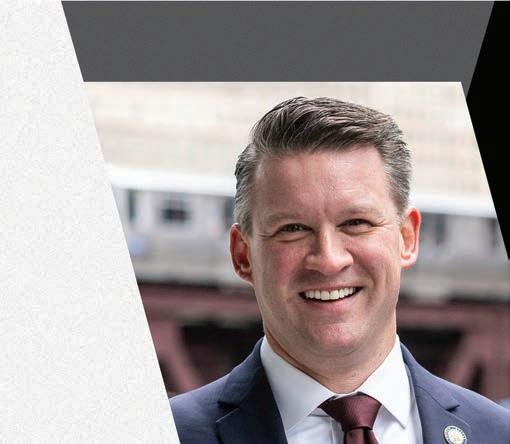


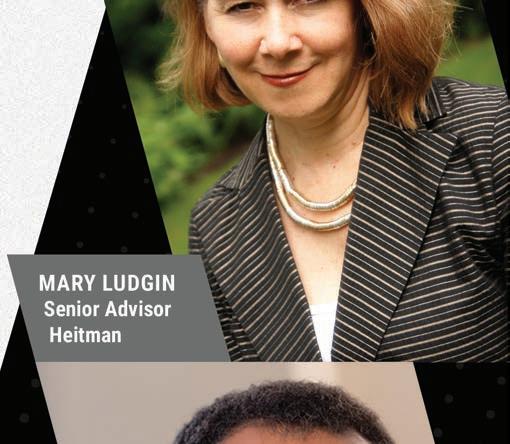
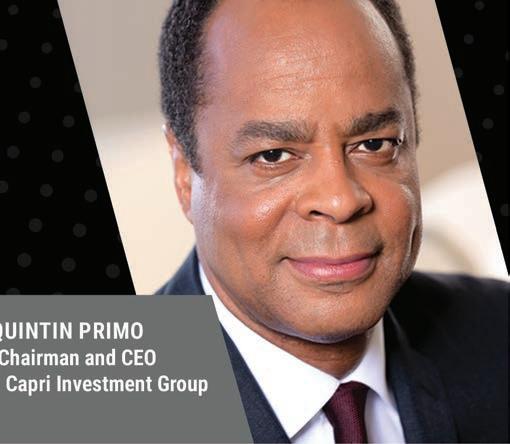



New media outlets have come online in recent years, but local journalism remains a fragile ecosystem I
These are tumultuous times at City Hall in south suburban Harvey. Last month, Mayor Christopher Clark ordered police to remove the audience from chambers after speakers critiqued the administration. In June, a preservationist and former planning commission member was arrested at a City Council meeting. At an earlier session, two local aldermen staged a walkout.
You can read all about it in the Harvey World Herald, a young online publication started by town native and recent New York University graduate Amethyst Davis.
An impoverished community 20 miles south of the Loop, Harvey has been without local news coverage for decades. “We’ve never really had any place for dialogue about policy issues, to be able to discuss the challenges faced in the community in a way and in a space where it doesn't devolve into fighting,” Davis says. “So I decided to go out on a limb, quit my job in New York and come back to Illinois.”
e Harvey World Herald is part of a new class of publications persevering to cover local news and niche markets, lling the gaps left by the hollowing out of traditional media. e rise of the inter-
net and collapse of the traditional advertising model has wiped out nearly onethird of U.S. newspapers since 2005. Residents in more than half of U.S. counties have no or very limited access to reliable local news sources, research by the Medill Local News Initiative at Northwestern University shows. In Illinois, four counties have no local news source and 34 rely on a single source, according to Medill. Hardest hit areas are downstate counties along with northwest Indiana, says Tim Franklin, senior associate dean at
See NEWS on Page 18

By Judith Crown
“We’ve never really had any place for dialogue about policy issues, to be able to discuss the challenges faced in the community in a way and in a space where it doesn’t devolve into ghting.”

they’re younger, mostly non-white and fed up with the corporate media’s portrayal of their communities
By
Frustrated and disappointed with how Chicago is often portrayed in mainstream media as the “murder capital” of America, three Black Northwestern University alumni set out to flip the script. In February 2017, Tiffany Walden, Morgan Elise Johnson and David Elutilo created The TRiiBE, a digital media platform on a mission to “reshape the narrative of Black Chicago” and give ownership back to the people.
“The TRiiBE was created to address a need that we saw in ourselves and our community to address anti-Blackness in journalism,” explains Johnson, who serves as the publication’s publisher. “We didn't see ourselves reflected in the media that we consumed, which was overwhelmingly showing images of state violence, intracommunity violence and sensationalizing violence against Black bodies.”
To put it another way, The TRiiBE challenges the journalism traditions that have historically centered white, patriarchal norms and measured success through page views and ratings. The publication’s core beats, which cover systemic racism, community investment, and arts and culture, aim to shed light on the challenges that Chicago’s most marginalized communities face, as well as “the beauty and power of Black Chicago's cultural and sociopolitical influence,” Johnson says.
“We make it our business to be outside in the community, documenting Black life beyond the trending topics of the day. We amplify the voice of community organizers in ways that Chicago's media landscape historically has not done,” she continues. “Instead of relying on sensationist narratives, The TRiiBE gives a fuller picture of the multifaceted Black Chicago experience. We can't let whiteowned, corporate media label us or use narratives to keep us in a state of despair.”
It’s a sentiment shared by Chasity Cooper, a local author and contributor to The TRiiBE.
“I just remember being so in awe that there was finally a very pointed outlet giving not just a millennial perspective on what it’s like being Black in Chicago, but really focusing on the culture stories and every facet of Black life that’s missed by the (Chicago) Tribune, by the (Chicago) Sun-Times and even by the (Chicago) Reader,” Cooper says. “What The TRiiBE does well is that they allow for new voices to give their perspective on Chicago.”
Cooper also appreciates The TRiiBE’s political coverage, which keeps a critical eye on happenings at City Hall and how policies im-

pact the communities at large.
“It’s not that they’re just reporting out, but they’re also reporting to the communities that need this information and otherwise might not get it, because mainstream publications might miss getting the news to these certain neighborhoods and communities.”
The TRiiBE isn't the only media outlet helmed by people of color that's holding elected officials accountable. In 2019, three community residents — April Alonso, Irene Romulo and Ankur Singh — founded Cicero Independiente to address the significant gap in independent bilingual news coverage for communities of color in the southwest suburbs of Chicago.
“We recognized the presence of institutional barriers that hindered the participation of individuals, particularly Spanish-speaking immigrants, in local decision-making spaces and the vital need for inclusive and representative reporting to change the status quo,” says Alonso, who is digital editor of the online publication. “In response, Cicero Independiente was founded as a news organization by, for and about people of color to empower community members as narrators of their own stories.”
But publishing local, independent news is not without its challenges. Last year, Cicero Independiente faced some intimidation and silencing attempts from Town Board President Larry Dominick, who called the newsroom’s journalists “jerks” for not standing during the Pledge of Allegiance and threat-
ened to ban them from speaking during public meetings. It should be noted that the free speech clause of the First Amendment of the U.S. Constitution gives people the right to protest the pledge.
Additionally, after publishing an article about a Cicero police officer who was accused of domestic violence, staff at Cicero Independiente received anonymous emails that contained foul language and the publication's co-founders received a letter with a story tip that was mailed to their homes. As a result, the newsroom collaborated with the International Women’s Media Foundation to create an online violence and abuse handbook and establish protocols to help freelancers and staff better protect themselves.
It’s a situation Johnson is familiar with as well.
“Because our publication uplifts movement work and calls out racism, we sometimes receive white supremacist threats. We've had to build safety protocols and mental health practices into our work,” says Johnson. “We understand that our journalism practice, which is modeled after the abolitionist Black press, will be attacked. We're here today because of our persistence and because of the strength of our community, which has held us up.”
The TRiiBE and Cicero Independiente credit community support with their success. While they both receive funding from philanthropic partners, readers and community members support the publications through newsletter subscriptions and donations.
The TRiiBE, which is a for-profit company, offers digital ads and sponsorships, while Cicero Independiente is a nonprofit newsroom fiscally sponsored by City Bureau, a nonprofit civic media organization based on the South Side of Chicago. Cicero Independiente is also part of the Medill Local News Initiative led by Northwestern University’s Medill School of Journalism, Media, Integrated Marketing Communications, which will help the outlet’s leadership team explore different revenue streams.
Daniel O. Ash, president of the Field Foundation of Illinois and former vice president of Chicago Public Media, sees the value in funding both nonprofit and forprofit newsrooms because, “regardless of their tax status,” both provide a much-needed public service. The foundation’s Journalism & Storytelling program was created in partnership with the John D. & Catherine T. MacArthur Foundation based on recommendations from local journalists of color, storytellers and other people involved in media. Current members of the Journalism & Storytelling portfolio include Chicago News Weekly, the Investigative Project on Race & Equity and the Invisible Institute.
“Funding local journalism is critical because our North Star, as a foundation, is to create the conditions that drive positive transformation,” Ash says. “The foundation has made a commitment to supporting the conditions for power-building in Black and Brown communities on the South and
West sides of the city. We support journalism, because we see journalism as a vital part of our local infrastructure that actually creates the conditions for residents to show up and be engaged in civic life.”
Ash points to legacy media outlets, such as the Chicago Defender, radio station WVON 1690-AM and N’Digo magazine, as both pillars among many Black residents in Chicago and examples of how to build trust in those communities. He also thinks outlets that are embedded in the communities they serve can create more civic engagement.
“When owners of media platforms are from the community, living in the community and are in a position to want to be held accountable by the community, the conditions for trust-building emerge,” he says.
And that’s what Johnson and Alonso aim to do with their respective newsrooms. Readers and writers like Cooper believe it’s working.
“I’m thinking of places like The TRiiBE, (the former) Vocalo, Cicero Independiente . . . what they do well is they make the connections with the respective communities and they also uplift the stories that are often missed by mainstream media,” says Cooper. “It’s so important for these niche publications to have space in the overall media landscape because they offer different perspectives. They offer more truth, more authenticity, more opportunity for young and emerging journalists to report and tell their stories.”


By Cassandra West
It’s the day before the Democratic National Convention opens. The stage is set for the eyes of the world to be on Chicago, and local TV news outlets have their cameras focused on protesters amassing on a corner of Wacker Drive and Michigan Avenue. The top headline on the website of local TV station ABC 7 Chicago (WLS-TV) reads, “First permitted protest to begin in the Loop on eve of Democratic Convention, closures in place.” The station’s chopper captures video of the growing crowd.
Visuals help make big news events even bigger, capturing eyeballs in ways a lot of words on a screen or paper can’t.
But a 6 p.m. appointment in front of the TV isn’t how people watch their local news anymore. Watching “the news” takes place on your own time and on your laptop, tablet or smartphone. “It’s not television,” veteran Chicago television political reporter Carol Marin says. “It’s video.”
And that video untethers viewers from a station’s schedule. Local broadcast news in Chicago is a 24/7 operation, made possible by always-on streaming channels. Viewers can find local news on free ad-supported streaming TV, or FAST, channels like Roku, Pluto TV and Tubi. CBS News Chicago streams hyperlocal news 24/7 on Pluto TV. Like linear channels, FAST channels combine live and prerecorded content, but there’s no monthly fee like cable. Scheduled commercial breaks are built into their programming. It’s a billion-dollar industry. Last year in the U.S., 57 % of TV viewers watched FAST platforms.
Where and how people get the news is rapidly changing, says Frank Whittaker, a former station manager and vice president of news for NBC 5 Chicago (WMAQ-TV). “It’s up to local news organizations, in particular, the legacy new organizations, to change along with it and stay with the audience,” he says. “Some stations have added newscasts to their main channel, but the big push in the last couple of years has been toward streaming channels.”
According to a May survey by Northwestern University’s Medill School of Journalism, Media, Integrated Marketing Communications, 66% of adults age 60 and older watch local TV news daily compared to only 22% of adults age 18-29. The same survey found that 53% of
adults consume local news at least once a day.
At the same time, local TV news audiences are shrinking as consumers cut the cable cord and switch to streaming.
The percentage of people who prefer to get local news from TV has dropped 22% since 2018, a Pew Research Center study published in May shows. An increasing share of Americans prefer to get local news online, while fewer get their news on TV or in print.
Before streaming and ondemand, Chicago-area audiences wanting local news turned on their television sets. TV was preferred over newspapers or radio. It made lots of money for station owners and it made local news anchors hometown celebrities.
Marin, NBC 5’s longtime political editor, who is one of the city’s best known TV anchors, says while some areas of the country have become news deserts, “I don’t think Chicago is one of them. . . .(But TV news) constricts and reacts the way all journalism does in this age of almost too much internet to be able to focus sometimes.”
And while stations all have political reporters, she says, “it’s harder these days for local stations to be as everywhere as they once were. You have to pick and choose what outlets are going to serve you. And, ultimately, you’ve got to make a kind of a patchwork quilt of where you get your news.”
Marin, who covered the recent Democratic National Convention for NBC’s national broadcast, also co-directs the Center for Journalism Integrity & Excellence at DePaul University, where she teaches the next generation of journalists. They’ve grown accustomed to getting news bites on phones, she says. What worries her most is seeing them jump into the business without the deep knowledge base that propelled the careers of earlier generations. “That’s worrisome for the country, for the culture.”
Yet a July survey by the Radio Television Digital News Association shows viewers are now being served a record-high amount of local news, says Caryn Ward, an associate professor at Medill who teaches multimedia journalism. “That’s because (broadcasters) are seeing that the future is streaming and people want news when they want it, not just at a prescribed 10 o’clock or 6 o’clock. You can stream it, but after a while, you’ve got to stream something new. And that’s where we’re going.”
Cook County residents prefer local media outlets
From which of the following types of media outlets do you typically get information (e.g., breaking news, expert opinions, event updates) about the greater Chicago area?
Local media outlets
Hybrid media outlets
Non-local (national) outlets
Other
Source: the Harris Poll, August 2024
Note: Local outlets cover only local news. Hybrid outlets mix local and national coverage, such as the Chicago tribune or WBEZ, and national outlets, such as the New York times, only occasionally cover Chicago-specific stories.
the Chicago area remains an oasis amid local news deserts tha t are spreading across the state and country
By William Johnson
To say that local U.S. journalism has been decimated over the last couple of decades would actually be an understatement. Decimating means reducing something by 10%, but the country will by the end of 2024 have lost one-third of its newspapers since 2005 as well as more than two-thirds of its newspaper journalists (43,000), according to researchers at the Medill School of Journalism, Media, Integrated Marketing Communications at Northwestern University.
Illinois is not immune to this devastation: While we have the thirdmost active news outlets in the country, 34 of our 103 counties are down to one local news source and four have none at all. An extraordinary number of Illinois newspaper jobs — 86% — disappeared between 2005 and 2023. Cook County remains an oasis amid the local news deserts that are spreading across the country and the state, with 127 outlets.
These are an important resource, which Chicagoans prize, according to a recent Harris Poll survey. To get information about the area, Cook County residents more often read locally focused media outlets (63%) than platforms that mix local and national coverage (we’ll call these “hybrid”), such as the Chicago Tribune or WBEZ (58%), or national outlets that only occasionally cover Chicago-specific stories, such as The New York Times (28%).
There’s a slight generation gap in news consumption habits in this area. Local news consumption goes up by age, for example, with 69% of those over 55 consuming it while a smaller majority (56%) of those age 18-34 do so. Conversely, more Chicago-area residents under 55 get area news from local outlets (30%) than

William
Johnson

their older neighbors (23%). And younger consumers (18-34) nearly twice as often as those over 55 get their Chicago news from other sources entirely (23% vs. 12%).
Localized outlets are also the top source of Chicagoland information for Cook County residents. Among residents who get information about the area from local-only outlets, 47% cite it as their primary source. Comparatively, 37% of those who get information from hybrid sources that cover a mix of stories consider it to be their primary source of information about the area, with a mere 8% each saying the same for national and other outlets. Again, there is an age element at work: A majority of those over 55 cite local news sources as where they primarily get information about the area (51%), while only 41% of those between 18 and 34 said the same.
It's not surprising then that local residents trust local and even regional outlets markedly more than national ones. More than 4 in 5 Cook County residents (83%) described the area information reported by outlets based in the area as being trustworthy, while only 63% said the same of national outlets. Similarly, 86% think both local and hybrid publications provide useful, relevant and actionable information, as opposed to 64% thinking the same for national outlets. Nearly 9 in 10 find the locally

based outlets to be more accessible (easy to find and easy to understand) than national outlets (of which just under 3 in 4 find to be accessible). The New York Times may be the paper of record for the nation, but Chicagoans prize Chicago-based news sources, in other words.
Chicagoans value our locally focused news sources and are fortunate to have an abundance of them. But we must remain aware of the broader trends: News deserts are growing, and while younger generations value local news, they don’t as much as their older compatriots, and there’s no guarantee that their interest will rise over time.
We need to act now to deal with news deserts elsewhere in the state before we find ourselves a news island or worse. There is some good news: In May, the Illinois Legislature included in the state budget $25 million in employment tax credits for journalists in local newsrooms and Gov. J.B. Pritzker signed the bill into law in June. The Legislature also passed the Strengthening Community Media Act, which would, among other things, dedicate 50% of state advertising to local media platforms. That bill has been sitting on Pritzker’s desk for several weeks now, awaiting his signature.
Involving government in the news business is a potentially fraught solution to a growing problem. There are legitimate concerns about where it could lead. And even if it’s properly handled, it will not be enough. Philanthropic efforts like the MacArthur and Knight foundations’ $500 million Press Forward initiative are also critical. Ultimately, a multidisciplinary effort, including the public and private sectors as well as charity, will be necessary to help revitalize and rebuild local media for the 21st century.
As a mentor to upand-coming journalists and consultant to news organizations, whether they are legacy or startups, profit or nonprofit, I often cite two priorities for those plotting local news’ future.
1. Growing audience is job No. 1, and email’s the key
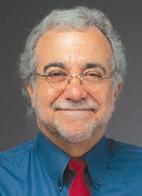
Charlie Meyerson is publisher of Chicago Public Square, an email news briefing serving the Chicago area.
That means: Gather people’s email addresses. The top of any news website should include an invitation to “Sign up for updates via email.” I’ve gone so far as to recommend one local publisher announce loudly — on front page wraparounds — something like “This print edition is going away on [this date]. If you want to keep getting the news, get us your email address now.” Then shut off the presses, pour all that production and distribution money into digital journalism, and charge advertisers a premium for reaching a community you’ll own like no other.
Email’s ability to connect all manner of content with an
audience makes it the logical successor to everything from a daily or weekly newspaper to a nightly or hourly newscast. It can alert subscribers to text, photos, podcasts, video and more. Unlike the ever-flowing rivers of social media or the vagaries of search engine behavior, your email will be seen. And unlike websites, which an audience must remember to visit, your email’s always there, waiting, whenever anyone checks the inbox.
That said: Whether anyone opens that email or not is overwhelmingly a function of the subject line. So the corollary: Make your email great. That means compelling, non-repetitive subject lines, where the most interesting and engaging words come first — and so won’t be obscured on small screens. It also means informative but tight content — a dispatch designed as a satisfying experience in itself but also engaging enough to get readers to




tap over to ad-supported web pages.
Bonus: Email can provide unmatched insights into your audience’s priorities.

2. Lose the paywall, put out the tip jar Paywalls crimp audience growth, and that limits what you can charge advertisers. People




won’t share content with friends or colleagues — your potential new readers — if those friends will smash, Wile E. Coyote-style, head-on into a paywall. A better approach: Make your content free for all — as public broadcasting and other media (notably in Chicago, the Sun-Times and the Reader) have done — but ask that growing audience to support your free content voluntarily. Maybe just 10% or 15% of your audience will kick in, but 10% of a growing number is … a growing number. (Compromise: A generous “gift link” program for paid readers.)
The mission’s vital
The plague of local government corruption, school and library book bans and election skulduggery with national consequences has made the importance of vibrant and engaging community news clearer than ever.
As a growing number of Americans get their news not on paper, but via phones and computers, the news business needs to meet them where they are. Email’s ideal for that— and for persuading them news is worth supporting.


part of the







To purchase tickets, learn more, and/or benefit from an event sponsorship, scan here or visit: metroplanning.org/events







Our city is fortunate to have become a breeding ground of new ideas about how to better inform our citizens and communities: Block Club Chicago. City Bureau. e marriage of Chicago Public Media and the Chicago SunTimes. e list goes on.
e rub is that no one has gured out how to make those good ideas nancially sustainable in the long term. is era’s promising generation of media entrepreneurs will need more time and resources to invent a better journalism, one that is more trusted, more valued, and therefore more stable.

Hugh Dellios is director of the journalism program at the Joyce Foundation and a former editor and correspondent at the Chicago Tribune, Associated Press and NPR. Joyce is a sponsor of Crain’s Forum.
at’s going to require investment. ose of us in philanthropy are proud to partner with these entrepreneurs and support their experiments, but it’s going to take a far bigger e ort, from all of us, and there’s no time to lose.
e return on that investment, what we’ll gain, isn’t just more headlines and more reporters. It’s more engaged communities, more informed policymaking, and more
accountability for our leaders — all building blocks for a stronger city. It’s not new for foundations to support independent journalism, media, and storytelling projects. What is new is a realization of how urgent the challenge is, as good information is increasingly crowded out by noise and misinformation, undermining our ability to come together and solve the rest of our most pressing issues.
e headline in journalism philanthropy is Press Forward, a collaboration of more than 60 funders that has amassed more than $500 million to revitalize local news across the country, led by the MacArthur Foundation. It now has almost two dozen local funding chapters, including one of the rst here in Chicago, hosted by e Chicago Community Trust.
e Joyce Foundation contributes to both campaigns.
Half a billion dollars? Seems like a lot. But it’s actually no match for a local-news crisis that infects almost every corner of the
country. More than $10 million has been raised in the Chicago area, but that, too, pales when seen against the steady, longterm loss of fact-based, trustworthy reporting across our city’s neighborhoods and suburbs.
Philanthropy is not the solution by itself. At best, it can be a bridge across this di cult stretch, to a
The real solution is helping media entrepreneurs restore the public’s appreciation for the value in real journalism.
time when the essential journalism we need has gured out how to be steady on its own again.
e real solution is helping media entrepreneurs restore the public’s appreciation for the value in real journalism — as distinguished from the infotainment and mischief that bombards us every day.
For news consumers, the investment starts with identifying and rewarding news sources that
We educate journalists to meet the times in which we live
When I tell people that I am the dean of a journalism school, I’m often greeted with looks of bemusement, bewilderment and pity. ose quizzical stares tend to be followed by questions like: “Why would anyone still study journalism?” and “Isn’t journalism dead as a profession?”
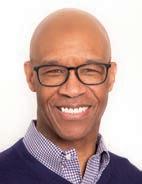
Charles Whitaker is a professor and dean of the Northwestern University Medill School of Journalism, Media, Integrated Marketing Communications.
I get it. Certainly, everything one reads about the news business, which has been upended by the digital revolution, suggests that the need to study journalism is about as relevant as the need to study wagon wheelmaking. I maintain, however, that it is because of the radical changes the digital age has brought to the production, distribution and consumption of information that journalism education is more needed than ever, and not just for those who hope to ply the trade as their profession.
e relative ease with which digi-
tal content can be created and distributed not only obliterated the business model that supported legacy media, it smashed the guardrails (it’s fair to also call them barriers) that helped maintain a degree of quality control over the information that oods the news ecosystem. Now, with waves of disinformation and misinformation, it is imperative that we prepare the next generation of news professionals not only with the skills to produce content for this new world, but to gather and distribute information responsibly and ethically. We also must equip these budding reporters and editors with the business-savvy to chart a course to industry sustainability.
At Medill, we’ve addressed the challenges and changes in media by crafting a platform-agnostic curriculum that trains students to produce content for all media. Our students are simultaneously
trained to write and edit textbased stories, to shoot and edit video and still pictures, as well as to produce audio stories. Writers must be camera-ready to discuss their stories in videos for every-
Journalism is one of the pillars that undergirds our democracy, which is threatened by disinformation, misinformation and the lack of trust in media.
thing from TikTok to YouTube. And since all journalism in the modern era is essentially digital (even if the media outlet a journalist works for still produces a paper product), students must develop a rudimentary understanding of coding and content distribution.





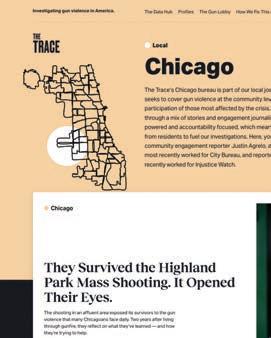





have proven themselves trustworthy. Pay for subscriptions to for-pro t newsrooms. Join membership programs and donate to the nonpro t news outlets you trust and enjoy — rather than just scrolling them for free. Buy tickets to live community events hosted by your local news outlet — one of many new revenue

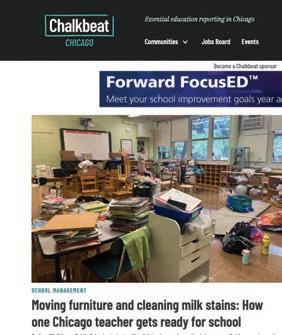





streams being developed. For business leaders, it means corporate sponsorships and advertising. ose with more means? Contribute to Press Forward Chicago, an ongoing campaign. Passionate about a certain issue, such as public education or gun violence? A number of dedicated news outlets have launched

We are also addressing the threat that generative AI poses to jobs and trust in media by experimenting with the technology as a tool for reporting and establishing — for our students and the industry — the parameters and standards under which this game-changing
technology should be used. ey must also be businesssavvy. In the old days, many in journalism believed that reporters were to be kept blissfully ignorant about the ways in which their enterprise was funded to prevent their journalism from being sul-
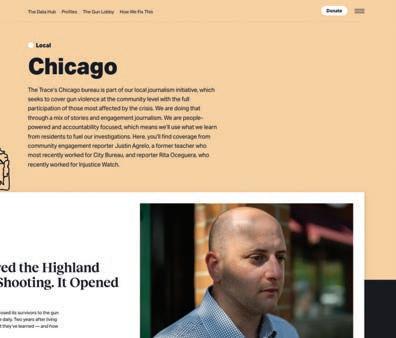

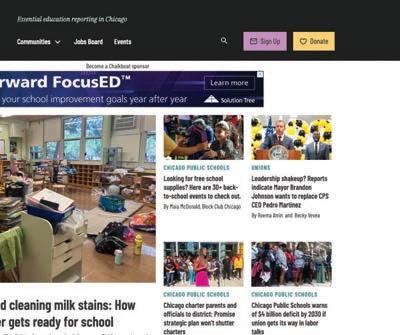

that dig into and illuminate these issues in fact-based, impactful ways. All of them need support and welcome it.
Better schools? Support Chalkbeat, a nonprofit newsroom focused on covering education policy in Chicago and Illinois, filling a void left when commercial media scaled back

lied by commercial concerns. As a result, when search engines and social media companies usurped that revenue on which media companies were dependent, writers and editors were illequipped to respond. Today, it’s essential to engage
its coverage.
Safer streets? e Trace is a national nonpro t dedicated to exploring the causes behind gun violence, the facts and research that help us better understand it, and solutions. Its Chicago bureau reports on community violence intervention and making sure those a ected are involved in how their stories are told.
A stronger voice for all communities in the metro area? Support Borderless, which focuses on the immigrant experience, or Southside Weekly, or Capital B, a national news startup that recently opened a bureau in Gary. is may sound simplistic and overly hopeful at a time when we all feel overwhelmed by media, and as “news avoidance” is increasing. One of the most alarming ndings in a recent Medill journalism school survey is that more than half of Chicago-area residents don’t think anyone should have to pay for local news. at’s understandable when times are hard, when we have become too accustomed to free information on the web, and when journalists have done a poor job of showing how costly real fact-based reporting is for real newsrooms.
But building and maintaining a strong city and a strong democracy was never going to be free, nor cheap. Real journalism supports both of those vital missions, and it’s worth every penny we can invest in it.
students in discussions about the business of media. Even as more media outlets become non-pro ts — which, as we remind students, is a tax status, not a business model — it is imperative that students learn how these non-pro ts generate revenue. We no longer just train journalists. We’re training the leaders who must develop and maintain the models that will support journalism of the future.
But perhaps the most important thing we can continue to do is to imbue our students with a sense of the tremendous responsibility that comes with providing fact-based information to the public. And we in journalism education must do a better job of helping the public understand the ethics that should govern the gathering and production of the “news” they consume.
Journalism is one of the pillars that undergirds our democracy, which is threatened by disinformation, misinformation and the lack of trust in media. Journalism schools have a responsibility to equip our students with the skills to battle those threats, and to provide everyone with a better understanding of how information should be produced. It’s not just the future of journalism that depends on us ful lling that mission. e future of the country may rest on it as well.
In 2023, I joined Clayco, a prominent, privately owned design-build and construction company with a workforce of 3,500 individuals. As executive director of Civic and Social Impact, I oversee the company’s investment in civic and social initiatives that further our five philanthropic pillars: scientific research, democracy, the arts, economic development and education.

Our country has a long way to go before we see a resurgence of local news, but more conversations are pointing to investing in a diverse independent media ecosystem as a crucial step toward a more informed and engaged citizenry.
As I got to know the impactful organizations Clayco supports through these pillars, I often found myself asking, “Why don’t more people know about this? How do we get the word out to more people?”
My questions led me to the importance of local media. Here in Chicago, we are fortunate to have a wide range of local nonprofit news organizations, such as Chicago Reader, Block Club Chicago, Injustice Watch, WTTW and others. But, as the MacArthur Foundation states as part of their Journalism & Media initiative, “Only a small percentage of journalism and media is created with an intention to engender deep understanding about current events…as a result, large segments of the American public are misinformed, disengaged, and cynical about their role as civic actors and agents for social change.”
at’s why, just this month, I joined the Reader Institute for Community Journalism’s Board of Directors. RICJ is the new nonpro t organization formed to protect and publish a newspaper I care deeply about, the Chicago Reader.
The Reader’s new business model — a mix of philanthropy and ad sales — means it can distribute more than 60,000 printed copies a week, free of charge. For thousands of Chicagoans who aren’t using technology to get the news, a free newspaper ensures that they have a place to find a voters guide before the local election, a place to learn about new artists, a place to feel connected to their city.
The Reader’s commitment to the Institute for Nonprofit News standards of editorial independence means that important stories aren’t swept under the rug because they don’t generate sales. Last November the Reader published a cover story about missing Black women and girls. It was reported and written by
A free newspaper ensures that Chicagoans have a place to nd a voters guide before the local election, a place to learn about new artists, a place to feel connected to their city.
partners at City Bureau and Invisible Institute. In May 2024, the reporters, Sarah Conway and Trina Reynolds-Tyler, won a Pulitzer Prize, and Mayor Brandon Johnson formed a task force on missing women in response.
Someone told me recently that whatever your first priority is as a donor, consider making journalism your second priority, at least for a little while. At a time in our country when quality journalism is often overlooked or taken for granted, consider supporting your local newsroom. In doing so, we are not only supporting professional journalists who work tirelessly to keep us informed, but also upholding the essential role that journalism plays in our democracy and our society as a whole.
Together, let us recognize and appreciate the invaluable contributions of local newsrooms in shaping our communities and driving positive change.
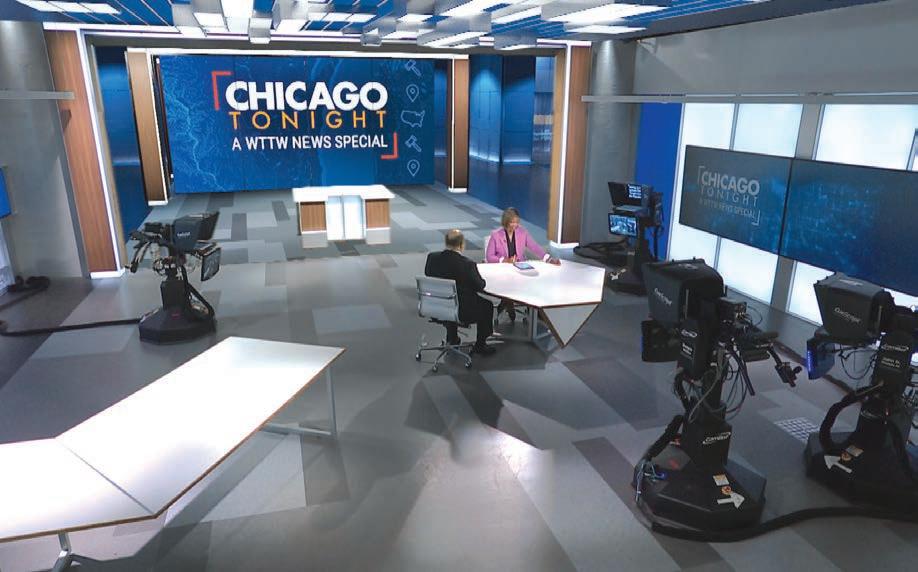
From Page 11
Northwestern's Medill School of Journalism, Media, Integrated Marketing Communications and a former high-level Chicago Tribune and Indianapolis Star editor.
The loss of local newspapers and magazines is not just the story of an antiquated business model that blew up in the internet age.
Consumers depend on news and information for the everyday needs of their lives, from where to dine to knowing whether it’s going to rain. It’s essential for civic participation, especially at a time when there are enormous stakes in local, state and national elections. “Research shows that when you lose local news in a community, civic participation declines, turnout in local elections goes down and the number of candidates running for public office goes down,” Franklin says.
The vacuum left by the contraction of local news has opened floodgates of misinformation on social media, talk radio, cable TV news and websites backed by political dark money. And without reporters on the ground tracking government spending, there’s a greater potential for wrongdoing.
“Having media play a watchdog role is incredibly important for preventing corruption and providing incentives for public officials to do the right thing,” says Illinois Sen. Steve Stadelman, D-Rockford, a former television reporter who sponsored bills earlier this year that provide tax credits for hiring journalists.
The Chicago metro area in recent years has seen a flowering of local nonprofit community publications that are catching notice, such as the Evanston RoundTable, Cicero Independiente and Block Club Chicago. In May, the Invisible Institute and City Bureau won a Pulitzer Prize for a series on how Chicago police have mishandled missing person cases, disproportionately impacting Black women and girls. That same month, the Invisible Institute won a second Pulitzer for an audio series revisiting an infamous hate crime on Chicago's South Side.
But local journalism is a fragile ecosystem. Where news used to be available for free, consumers are now reluctant to pay for news online. Paywalls and digital advertising don’t begin to compensate for the loss of lucrative print ads that once funded local news. Philanthropy has stepped up, notably through Press Forward, a $500 million, five-year national initiative to invest in local news led by the John D. & Catherine T. MacArthur Foundation. But finding a profitable business model is elusive.
the Medill Local News Initiative surveyed 1,004 people in the Chicago area about their news consumption habits. Higher percentages of respondents are presented in blue, and lower percentages are in red.
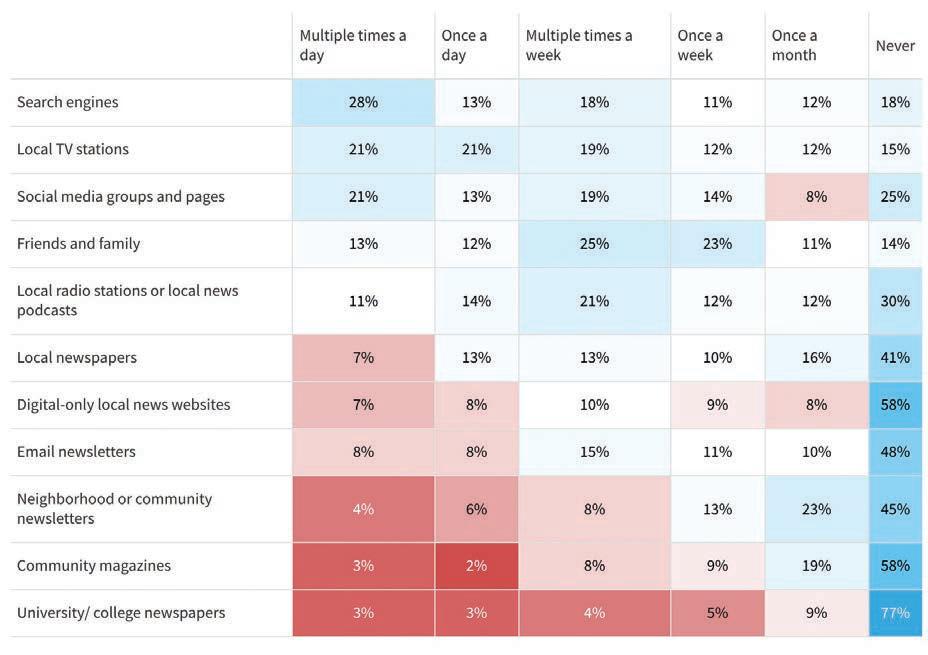
Source: Medill Local News Initiative, 2024
Note: Because of rounding and the omission of missing responses, rows may not total 100.
Laws and policies Elections
Source: Pew Research Center survey conducted Jan. 22-28, 2024
Press Forward Chicago, housed at The Chicago Community Trust, awarded a total of $1.6 million to 13 local news organizations in May as part of a $10 million funding. “We’re at the very early stages of being able to lift up some new thinking, some new solutions, and kick the tires on some ideas that seem to be promising,” says Chicago Community Trust President Andrea Sáenz.
Consumers don’t want to pay
The rise of the internet all but decimated the traditional news business model. Ad revenue at publicly traded newspaper companies nationwide declined to $9.8 billion in 2022 from nearly $50 billion in 2009, according to the Pew Research Center. Illinois ranks among the top 10 states for the most newspapers lost. Journalism jobs at newspapers in the state have plunged by 86% since 2005. The mighty Chicago Tribune, now owned by hedge fund Alden Global Capital, is a shadow of its former self, having lost 82% of its newsroom staff since 2005. It once operated close to 10 foreign bureaus. That presence is gone, as news coverage has been scaled back overall. There are fewer reporters covering basketball and hockey games on the road, fewer music critics at concerts, a lighter presence in the suburbs and a reduced focus on Chicago's large companies.
Smaller community newspapers also no longer have the manpower to cover the government bodies that are accountable to the public: city councils, schools, park and library boards. If you don’t have reporters on the ground, the community won’t know what’s going on and there’s no one to keep public officials accountable, Stadelman, the state senator, says.
Consumers now read much of their news online and they’re not particularly inclined to pay for it, especially because they once had been able to retrieve it for free. Where Chicago Tribune and Chicago Sun-Times newspapers once cost 25 cents on the street, suburban readers pay $2 to pick up a copy at a 7-Eleven. In fact, 57% of the Chicago-area consumers surveyed by the Medill Local News Initiative said no one should pay for national news and 51% said no one should pay for local news, while only 8% said everyone should pay.
Alternative revenue sources, such as paywalls, special events, advertiser-funded “advertorials” and merchandise, only go so far. To cover the gap, foundations, both public and private, began supporting the growing number of nonprofit newsrooms as well as some for-profit publishers. (Crain’s Chicago Business receives foundation funding for its public-service Forum and Equity sections.)
The reading habits of Oak Park resident Laurie Casey reflect the
flight from traditional newspapers. She canceled her Chicago Tribune subscription because she felt the costs were exorbitant. And she stopped her Chicago Sun-Times subscription when the print editions became thin, although she’s considering resubscribing since the newspaper merged with radio station WBEZ. She and her husband subscribe to The New York Times and The Washington Post, but she hasn’t been happy with their political coverage.
“We’re regular monthly subscribers of WBEZ, WTTW, the Wednesday Journal (of Oak Park and River Forest newspaper) and Block Club Chicago,” she says. “I’m also on Twitter and Facebook and get some national news there.”
In 2019, local media outlets calling themselves the Chicago Independent Media Alliance, or CIMA, began advocating for foundation help as well as assistance from the state of Illinois. “We were looking for a pooled fund for journalism,” says Tracy Baim, co-founder of the Windy City Times and former publisher of the Chicago Reader.
That effort led to the national Press Forward initiative, which launched in September 2023
necessary for an organization to be sustainable in the long term.”
The $1.6 million funding among 13 news organizations won’t stretch that far. It gives them less than $125,000 each on average. Saenz says The Chicago Community Trust will now “take a step back” to evaluate its next moves and expects to issue a second request for proposals early next year.
Will publications be dependent on philanthropy?
One news organization that received Press Forward funding is the Pulitzer Prize-winning Invisible Institute. The nonprofit grew out of the work of local investigative reporter and human rights activist Jamie Kalven, who published groundbreaking work on public housing and police abuse. “Sixteen Shots,” his 2015 exposé in the online magazine Slate that detailed the fatal shooting of 17-year-old Laquan McDonald by Chicago police, triggered a wave of political repercussions.
The Invisible Institute is funded by a mix of foundations and donors, says Executive Director Andrew Fan. It also earns revenue through partnerships with
Consumers now read much of their news online and they’re not particularly inclined to pay for it, especially because they once had been able to retrieve it for free.
with funding from more than 20 foundations. The MacArthur Foundation committed $175 million to local journalism as part of the effort. The program established local Press Forward chapters in more than 20 communities, including Chicago.
In addition to the MacArthur Foundation and The Chicago Community Trust, Press Forward Chicago donors include the Amy Falls & Hartley Rogers Foundation, the Joyce Foundation, the Polk Bros. Foundation and the Pritzker Pucker Family Foundation.
“The foundations recognized more and more that we're an important leg to democracy and keeping communities vibrant,” says Shamus Toomey, publisher and co-founder of Block Club Chicago.
In funding the first group of 13 local news organizations, Saenz says The Chicago Community Trust focused on smaller publications that need to build staffing and operations. Funds might be used for positions needed to grow revenue, such as managers for business strategy, audience development or advertising sales.
“We want to help them figure out how to pay for the kinds of things that their regular revenue sources may not be excited to fund,” Saenz says. “I’ll use the word 'unsexy' things, but these are
ald's founder, notes that the city of Harvey has to apply for grant dollars in order to tear down the abandoned structures.
“I don't necessarily think that the future of journalism is exclusively going to be dependent upon philanthropy, but I do think they need to do more than they already are doing,” Davis says. While the Harvey World Herald is up and running, the publication needs what she calls transformational dollars to hire more full-time staff and build operations. Davis currently is the only full-time staff member, with 17 freelancers for reporting, photography and video.
Davis has received the bulk of her startup’s funding from the Chicago-based Square One Foundation, along with grants from the Field Foundation of Illinois, the Crossroads Fund and the Google News Initiative, among others.
Journalistically, the Herald is shaking things up. “Davis is doing a really good job of being impartial and fair,” says Glynis James-Watson, a Harvey resident and donor. “But the way things are going in Harvey, it’s not all good news. She has to report it as she sees it.” People appreciate that Davis is on the job and are eager to pass along tips when something is going on, James-Watson adds.
the number of local news sources continue to shrink. thirty-four counties in Illinois have one local news source, while four counties have none.

media organizations that publish the institute's work.
Its coverage on the South and West sides of Chicago aims to reach people who don't have the capacity to pay for traditional media, Fan says. “But they need coverage to know what's going on in their communities and to participate in the democratic process,” he adds.
The work of the Invisible Institute and upstart Harvey World Herald raises the question of who will fund the much-needed coverage of less-affluent neighborhoods that typically don’t attract advertisers and big donations from local residents.
“We hear the foundations wanting us to find revenue sources, to think creatively and be strategic,” Fan says. But covering these communities may never be profitable, he adds. The organization’s long-term goal is to shift toward more individual donations and build a wider base of support.
Funding also is a challenge for the Harvey World Herald, given the community’s median income of $40,898, according to U.S. census data, with about a quarter of the population under the poverty line. The median home price in June was $110,000, according to Redfin, and at least 300 abandoned homes in the area are boarded up, according to press reports. Davis, the Her-
One young organization that’s gained traction is Block Club Chicago, a nonprofit online newspaper focused on local and neighborhood news. With a citywide circulation of 130,000, including paid circulation of 20,000, it enjoys a wider base of readers and potential advertisers. Coverage includes breaking news, offbeat neighborhood features and recommendations for weekend entertainment.
“We see a lot of Chicagoans hungry for news about things happening close to them,” says publisher Toomey. “We like to think those are our readers, the people that remembered how coverage used to be, but also younger readers that maybe had never opened a newspaper before. Now they're starting to get used to us, whether by email or by Instagram or by TikTok,” he says, referencing how Block Club uses social media to drive traffic.
Block Club has grown to annual revenue of $4.2 million, with grants accounting for 63% of that and subscriptions bringing in 25% last year. The publication aims to reduce dependence on philanthropy and boost donations and advertising, which last year accounted for 3% and 8% of revenue, respectively.
Block Club in 2021 won a $1.6 million grant from the American Journalism Project, which it used to fund newly created business positions: a senior vice president of revenue, a director of sales, an operations manager,
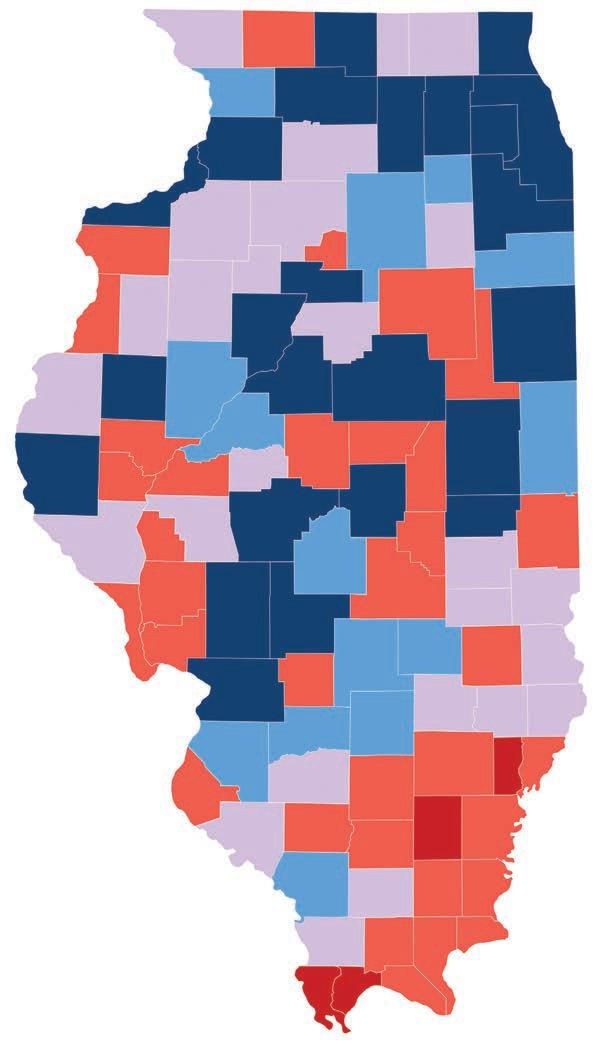
source: Northwestern university
a director of member services and a major gifts officer.
“We've seen a lot of places get overly reliant on foundation gifts,” Toomey says. “They’re great, but you have to worry about their changing goals. Other things come along that become new priorities. You need a mix of things and you have to be careful with each of them and nurture them.”
In addition to millions of dollars in foundation funding, the state of Illinois has adopted incentives to help local news organizations. As part of the 2025 state budget, the General Assembly approved a withholding tax credit of $5 million a year for the next five years. Illinois newsrooms can apply to the state and receive a maximum benefit of $15,000 for an employed reporter and $10,000 for new hires. Credits are capped at $150,000 per newsroom and $250,000 for corporations.
The effort was led by Stadelman, the state senator from Rockford. Tax credits won’t solve the financial problems of
local media, but they’re “another tool in the toolbox,” he says. Another bill passed by the General Assembly that goes into effect in January will provide journalism scholarships and require local news organizations to alert their employees as well as the Illinois Department of Commerce & Economic Opportunity 120 days before a sale, providing a chance for buyers within the state to intervene and maintain local ownership.
A state proposal would also require tech giants such as Meta and Google to compensate local news operations for content published on their sites, but Stadelman says he’s holding off pushing this while a similar measure is debated in California.
But state government, he says, has an interest in facilitating local journalism. “We're not telling reporters what to report,” Stadelman adds. “We want to make sure there are reporters on the ground, covering local issues. The watchdog spotlight role is incredibly important for the democratic process.”
ADP is nearing a deal to sublease about 150,000 square feet from the insurance giant in the northwest suburb
By Danny Ecker
Zurich North America is closing in on a deal to offload another big chunk of its Schaumburg headquarters, showing how badly companies want to be in the newest and nicest offices they can find to help get employees to show up.
Human resources services provider ADP is in advanced discussions to sublease around 150,000 square feet from the insurance giant at 1299 Zurich Way in the northwest suburb, according to people familiar with the talks. If the deal is completed, ADP would relocate its suburban Chicago workforce to the property from Elk Grove Village, sources said.
The company last year sold its 242,000-square-foot longtime office building at 100 Northwest Point Blvd. to a data center operator that plans to raze it as part of a broader redevelopment project.
ADP’s move would fill the rest of a roughly 360,000-square-foot block of office space Zurich listed on the sublease market last summer, an offering that accounts for almost half of the insurance company’s glassy, 11-story building along Interstate 90. Zurich struck a deal earlier this year with fleet management company Wheels to take more than 200,000 square feet of that space.
Zurich’s success in finding takers for its space highlights companies’ appetite for new and updated office space in the wake of the COVID-19 pandemic. Many are seeking to upgrade their workspace as they grapple with

ADP’s move would fill the rest of a roughly 360,000-square-foot block of office space Zurich listed on the sublease market last summer.
the remote work movement and look for ways to encourage in-person collaboration among employees.
Zurich’s bespoke office building was completed in 2016, making the amenity-laden, 39-acre project one of the newest office properties in the Chicago suburbs. The move-in-ready space for sublease gets the attention of prospective office tenants at a time when many are wary of committing large amounts of capital to new office build-outs.
It’s unclear what prompted ADP to target the Zurich property as its new home, and spokesmen for the Roseland, N.J.-based company did not respond to requests for comment. A Zurich spokes-
woman declined to comment. ADP, which companies hire to provide third-party human resources services, also has a downtown Chicago office at Willis Tower and a small office in Deerfield, according to ADP’s website. It’s not immediately clear if or how those offices would be impacted by the Zurich lease.
Suburban office landlords may lament ADP taking space from Zurich instead of filling some of the record amount of direct availability in the market. High-quality sublease listings are a thorn in building owners’ side as companies like Zurich shrink their footprints and one reason the suburban office vacancy rate has hit record highs in 14 straight quarters.
But ADP’s move would be celebrated by the village of Schaumburg, which stands to get the foot traffic it was hoping for when it incentivized Zurich to build its new headquarters in the community. Zurich and the village have been in a legal battle over the past couple years over the insurance company’s use — or lack thereof — of its physical office space.
Zurich alleged in a 2022 lawsuit that the village owes it millions of dollars in property tax reimbursements it was promised under an agreement to develop a new headquarters with at least 1,700 workers. The village counted on those employees dining at lunch spots, filling up at local gas
stations and shopping at nearby grocery stories, among other local economy-driving activities.
But Zurich employees weren’t around as much on a daily basis after the public health crisis, and in 2020, Schaumburg proposed renegotiating the incentive agreement, according to the lawsuit. In 2021, the village refused to make any reimbursement payments to Zurich, the company alleged in the complaint, which is still pending in Cook County Circuit Court.
Zurich argued that the tax incentive agreement requires only that its employees be “assigned” to that office, whether or not they’re physically there every day. The company said in the complaint that about 2,100 employees were assigned to the building as of early 2021 and that missed reimbursements had cost Zurich $5.5 million at the time the lawsuit was filed.
The 783,000-square-foot property is owned by a venture of Atlanta-based Stonemont Financial, and Zurich leases the building through mid-2042. Zurich North America is the U.S. arm of Swiss insurance giant Zurich Insurance Group.
ADP last year sold its Elk Grove Village building to Plano, Texas-based Aligned Data Centers for $28.5 million, according to Cook County property records. ADC earlier this year unveiled a $285 million proposal to demolish the property and three other neighboring office buildings in the Northwest Point office complex and build two data centers and an electrical substation in their place.
Chicago
By Rachel Herzog
A Chicago entrepreneur appears to be planning a new magic-themed dining and entertainment concept at a shuttered restaurant space steps from the Magnificent Mile.
An entity led by Glen Tullman, a venture capitalist and former Allscripts CEO, has entered into a lease agreement with the owner of 100 E. Ontario St., a historic building just west of Michigan Avenue, according to Cook County property records. The space was home to Lawry’s The Prime Rib for more than four decades until the steakhouse closed in 2020. Chicago-based real estate firm Northpond Partners acquired the property for almost $7.7 million in 2021 as a redevelopment play, according to the company’s website and county property records. The venture that bought the building appears to have ties to another Chicago real estate firm, MAC Management; state
business records list a MAC executive as the entity’s manager.
“We are thrilled to bring a new entertainment experience to Chicago and expect to be ready to share more publicly soon,”
MAC principal Dustin Cahan said in an email Aug. 16. Cahan did not provide further details, and Tullman and Northpond didn’t respond to requests for comment.
The specifics of the concept weren’t immediately clear, but sources familiar with the plans understood it to be a restaurant with a magic and entertainment component. The name of the tenant on the lease memorandum, Metamorphosis Chicago LLC, also appears to reference a stage illusion.
Tullman attempted something along those lines in the 1990s, planning restaurants in New York City and Orlando, Fla., centered around legendary illusionist David Copperfield, but the project fell apart and the venues never
opened, according to a New York Times report.
The 10-year lease at 100 E. Ontario St. will begin either with the business opening to the public or on Oct. 15, 2025, whichever comes first, according to county records.
In the meantime, a significant redevelopment of the property appears to be underway. The city issued permits for an interior renovation and a rooftop addition to the three-story building earlier this month, according to the public database.
In July, the Northpond venture received a $13.5 million mortgage on the property from another entity controlled by Tullman that’s also named for a magic trick, Three Doves LLC, records show.
The building at 100 E. Ontario St. was first built in 1889 as a private home for the McCormick family, then converted to a puppet theater in the 1950s, according to Northpond’s website.

An entertainment concept at the site would add to the wave of experiential retailers, such as the Museum of Ice Cream at the base of Tribune Tower, now occupying space on and near the Mag Mile, the shopping corridor that’s contended with high storefront vacancy since the onset of the COVID-19 pandemic.
Mid-America Real Estate brokers Paul Bryant, Greg Bayer and Kelly Nickele had been marketing the 49,000-square-foot property at 100 E. Ontario St. for lease, according to a brochure.
Options for vibrant culture, delectable cuisine and unforgettable entertainment.
AIRE ROOFTOP BAR
100 W. Monroe St., 24th Floor, Chicago, IL 60603 773-598-8324 • airechicago.com
Experience Aire Rooftop Bar, 24 stories above Chicago, with stunning city views, a Tiki-bar, open fireplaces, and a vibrant atmosphere. Perfect for team outings, happy hour, weekend brunch or cocktail parties. Join us every Sunday for Concert Under The Stars. Elevate your next event and book our exclusive party packages through our website.

MARISOL RESTAURANT AND BAR
205 E. Pearson St., Chicago, IL, 60611 312-799-3599 • marisolchicago.com
Located in the Museum of Contemporary Art, Marisol Restaurant & Bar is a unique extension of the contemporary art experience. Featuring an innovative, seasonal menu from James Beard Award-winning Chef Jason Hammel and an immersive interior designed by renowned artist Chris Ofili, Marisol is perfect for business lunches, special occasions, or any event requiring a private dining space.

MORETTI’S RESTAURANTS
Visit our website for our locations across Chicagoland morettisrestaurants.com
Moretti’s was founded in Chicago and is 100% family-owned and exclusive to the Chicago area. The original Moretti’s is on the northwest side of Chicago. Ten other locations serve the north and west metro area. Moretti’s original family recipes range from traditional to the latest delicious trends. All ingredients are fresh, and everything is handcrafted to order.






















































































































































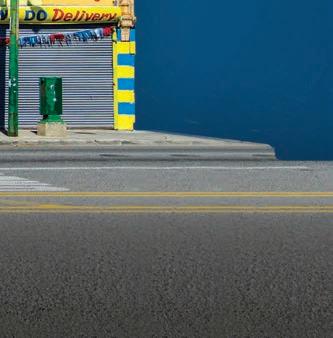


His pioneering show proved daytime audiences — largely women — were eager to explore topics beyond celebrity chat
By Phil Rosenthal
It’s easy to forget that before the internet, before social media, there weren’t a lot of places for everyday Americans to see and hear others express views they shared and ask questions they wanted answered.
“The Phil Donahue Show” built its phenomenal nationally syndicated success as one of those rare places, one particularly appealing for housebound women paternal TV long underestimated as interested only in pap.
Phil Donahue, who died Aug. 18 at age 88, presided over what amounted to the People’s Press Conference five days a week from 1967 to 1996, its pre-eminence coinciding with the 11-year, 1974-85 stint in which his signature show was produced in Chicago.
“Donahue” (as his program came to be known) encouraged audience members and callers to engage with the guests, join in on debates and share their own experiences on a variety of subjects.
So viewers at home got to see and hear people like themselves
on subject matters serious and silly alike, which was something close to revolutionary at its launch in Dayton, Ohio, and dully commonplace 29 years later, when the show petered out in New York.
The audience didn’t always have to agree with him — as an outspoken liberal on most subjects, surely many viewers didn’t — because there was always someone in the studio who got the microphone to disagree with whatever he was saying.
Donahue’s show evolved much as he had, shedding the traditions and orthodoxies on which he was raised en route to embracing feminism in the 1960s. Courting the hearts and minds of his audience, he gave women a voice and embraced their points of view.
He often said questions from callers and members of his studio audience were better than his own. No doubt, they were baked into his success.
Oprah Winfrey, whose own Chicago-based show seemed to chase Donahue from the Midwest and ultimately ended his reign, prevailed not merely by providing
By Lily Meier, Bloomberg
For Starbucks Corp., its primary home is Seattle.
Yet its freshly minted chief executive officer isn’t living in the same city or even state as its headquarters — an emerging trend of top leaders living a plane ride away at a time when many employees are forced to return to the office.
Indeed, this month Victoria’s Secret, based in Columbus, Ohio, named a new CEO who will be in New York.
Brian Niccol, the new CEO of Starbucks, won’t be required to move to Seattle, where the company is based, even though he’ll be spending much of his time there. He is also getting a remote office in Newport Beach, California, where his former employer Chipotle Mexican Grill is located. Hillary Super, who was poached from Rihanna’s lingerie brand to be the next leader at Victoria’s Secret, will be moving from California to live in New York.
Both executives have agreed to commute frequently for their role. Starbucks will allow Niccol to use its corporate plane, and Victoria’s Secret will cover Super’s travel expenses.
They are joining the growing ranks of corporate leaders being given the option to run their businesses from hundreds or thousands of miles away, at least some of the time.
Kelly Ortberg, who became Boeing’s CEO this month, will be based in Seattle — near much of
Phil Donahue

that same sort of platform. She and other rising hosts were emblematic of Donahue’s audience.
Donahue, however, was a pioneer, one of the people who helped turn TV into what we know it as today.
The town hall format didn’t begin with him, but he brought it to the fore, especially when it came to playing one side against the other on a topic. He wasn’t necessarily confrontational, and he rarely broke news, but he sought sparks. The subjects he embraced, once deemed breakthrough, are everywhere today.
the company’s production — rather than its corporate headquarters in Arlington, Virginia. United Airlines’ Scott Kirby splits his time between his primary residence in Dallas and Chicago, where his company is based.
That’s a stark contrast to corporate employees, many of whom are facing a return-to-office mandate.
White-collar employees at Starbucks, for example, were required at the beginning of last year to return to the office at least three days a week, a move that sparked backlash from some workers.
Some Victoria’s Secret employees are in the office, while others are allowed to work remotely. Super isn’t the first or only senior executive at her company to be based outside of Ohio. The company’s brand president and head of design both live in New York.
“We have headquarter offices in many locations, including New York,” a Victoria’s Secret spokesperson said in a statement. “For us, what’s most important is that our teams feel supported no matter where they are based.”
Super’s predecessor, Martin Waters, was also based in New York and would visit the Ohio facilities frequently.
Niccol, who moved Chipotle’s headquarters from Denver, isn’t following precedent at Starbucks. The coffee chain’s previous CEO, Laxman Narasimhan, relocated to Seattle from the UK. Niccol will spend the majority of his time at the Seattle headquarters, according to a Starbucks spokesperson.
Having worked briefly in ad sales, Donahue seized on whatever sold. He found new things to televise (like the birth of a child)
and discuss (like sexual misconduct in the Catholic church). He swung back and forth between high-minded and low-brow. Some of it, to be fair, was schlock.
But before “Donahue,” much of daytime talk was fame-focused idolatry served up by likes of Merv Griffin, Mike Douglas and Dinah Shore. Gary Deeb, the influential syndicated Chicago TV critic, noted Donahue’s fare reduced theirs “to the level of Tupperware parties.”
When celebrities did show up, Donahue and his audience expected them to open up. So they did. Newsmakers, too.
Without the success of “Donahue” and, later, “The Oprah Winfrey Show,” who knows if Chicago becomes the magnet for syndicat-
ed daytime TV production that it was for years, as home to shows with Jerry Springer, Jenny Jones, Judge Greg Mathis and others.
The popularity of “Donahue” in Chicago, first broadcast out of WGN-TV/Channel 9’s studios and then WBBM-TV/Channel 2’s, restored must-visit status for A-listers to a degree unseen since middle America became flyover country. That trend would peak with Winfrey and ebb when she packed up for California 13 years ago.
Sometimes a presumably hot-button issue proved not so hot.
A 1983 “Donahue” program on what for decades has been a reliable fire-starter found the studio audience, callers and a panel of radio stars — Howard Stern, Larry Lujack, Jonathon Brandmeier and Dick Biondi — all shrugging off the suggestion that song lyrics on the radio posed a threat.
“Am I the only old person in the room?” Donahue, then 47, said as he bounced across the studio in desperate search for someone, anyone, upset kids might hear John Mellencamp’s “Hurts So Good.”
But Donahue was never the only person in the room, and he made sure viewers saw that.
In doing so, they got to see and hear themselves.
Phil Rosenthal is a former media columnist, business columnist and sports columnist for the Chicago Tribune, and a former columnist and critic for the Chicago Sun-Times and Los Angeles Daily News.

To place your listing, contact Suzanne Janik at (313) 446-0455 or email sjanik@crain.com .www.chicagobusiness.com/classi
SERVICES OFFERED seeksa inChicago,ILtodrivegrowthand profitabilityinthebusiness.100%telecom. permittedw/intheU.S.Apply https://www.jobpostingtoday.com/Ref#94783.

Are you passionate about the environment in the Midwest? Do you care about protecting the Great Lakes and accelerating the transition to clean energy? How about the legacy we will leave for future generations?
If you’re a development professional with experience in major & planned gifts and demonstrated results, we want to talk with you! Join our winning team of talented, mission-driven professionals, that works together to protect the environment and natural resources in the Midwest. Full Job Description and Requirements at jobs.chicagobusiness.com





At its core is a strategy to invest in six key industries that will receive ‘prioritized support,’ capital investment and job training
By
The Illinois Department of Commerce and Economic Opportunity this month published a fiveyear plan outlining how it hopes to attract and retain businesses in the state.
At the plan’s center is a strategy to invest in six industries that will receive “prioritized support,” capital investment and job training. They are life science, quantum computing, clean energy production, advanced manufacturing, next generation agriculture and transportation.
Some of these industries, including agriculture, have long been staples of the state’s economy. Others, like clean energy and quantum computing, have become policy priorities for the administration of Gov. J.B. Pritzker in recent years.
In the last two years, the state has given just over $1 billion in tax incentives to companies in the supply chain for electric vehicles and clean energy production through the Reimagining Energy and Vehicles program.
Last month, the state awarded a $92 million tax incentive to quantum technology company PsiQuantum Manufacturing under the Illinois Chips for Real Opportunity Act, the first agreement of its kind.
Deals brokered through those programs are often part of larger packages of tax breaks, statebacked loans and other incentives. The governor’s office estimated PsiQuantum’s total incentives package was worth $200 million.
The five-year plan was put together by DCEO in “consistent collaboration and consultation” with Intersect Illinois, a nonprofit economic development agency founded eight years ago with
backing from then-Gov. Bruce Rauner.
Intersect is a major player in “Team Illinois,” an informal coalition of business groups and government officials that lobbies companies to set up shop in Illinois. The group, which has so far operated on a somewhat ad hoc basis, consists of the governor’s office, DCEO, Intersect, trade associations, public utilities and other groups, according to the department’s five-year plan.
DCEO’s plan also said it is formalizing the process these groups use to court new business developments, hoping to operate as a “unified front” for attracting investment.
The plan also lays out several proposed “areas for improvement” to state policy on business incentives. These include expanding the incentive program available to advanced manufacturers like vehicle and electronic manufacturers, granting regional economic development officials the ability to establish geographic “enterprise zones” that provide tax breaks, and further extending a tax credit for research and development.
Pritzker on Aug. 13 kicked off a decadelong process to address the needs of aging Illinoisans, signing an executive order to hire a chief planning officer within the state’s Department on Aging.
With the U.S. Census Bureau estimating that approximately one quarter of Illinois’ population expected to be 60 or older by 2030, the chief planning officer will oversee the creation of a 10-year strategic plan “with the goal of strengthening Illinois as an aging-friendly state,” according to the executive order.
Pritzker’s office did not indicate who might fill that role, but after
the position is filled, the clock will start ticking toward a December 2025 deadline to deliver a comprehensive plan to the governor and the General Assembly that could eventually be turned into policy.
In his second term as governor, Pritzker has proposed more state investments in areas like child care and preschool, but he has not yet launched any large-scale efforts to address the growing needs of caretaking for elder adults, especially as the Baby Boomer generation ages.
“We know that it’s not just about supporting aging adults, but also being mindful of caretaker needs and the complex needs of individuals with disabilities, and this plan will ensure no one is left behind,” the governor said in a statement announcing the executive order.
For more than two decades, the state has operated the Illinois Caregiver Support Program, which offers resources to those taking care of elderly parents, neighbors and grandparents — along with grandparents who are raising their grandchildren. But the program is small and not well-known.
Past governors’ administrations have made two-year plans on aging, which continued under Pritzker as Illinois is currently on the state’s fifth such plan. Under the 10-year plan, the state’s chief planning officer is asked to coordinate across agencies including the Departments of Corrections, Insurance and Housing.
Capitol News Illinois is a nonprofit, nonpartisan news service covering state government. It is distributed to hundreds of newspapers, radio and TV stations statewide. It is funded primarily by the Illinois Press Foundation and the Robert R. McCormick Foundation, along with major contributions from the Illinois Broadcasters Foundation and Southern Illinois Editorial Association.
FGM Architects, Oak Brook
Mike Elliott, AIA, NCARB has been promoted to Vice President at FGM Architects (FGMA), an employee-owned firm offering architecture, planning and interior design services nationally in 8 offices across 5 states. Elliott joined FGMA as a Principal in its Municipal practice. Elliott is a former President of AIA Illinois and AIA Northeast Illinois, a representative to the AIA National Strategic Council, and a member of the AIA National Government Advocacy Committee.

All-Tech Decorating Co., Romeoville
All-Tech Decorating Co. is pleased to announce Steve Popp as Field Operations Director. Steve has been with ATD for 20 years and has been an influential leader within the organization. Steve started his career with ATD as a Driver, moved into Estimating/Project Management, and has been integral in the management and development of our Field Operations over the past few years. Steve will use his years of experience to guide the ATD Field in our commitment to excellence.

AECOM Hunt, Chicago

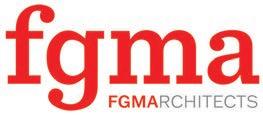
FGM Architects, Oak Brook
Cory Kamholz, AIA, LEED AP, has been promoted to Vice President at FGM Architects (FGMA), an employee-owned firm offering architecture, planning and interior design services nationally in 8 offices across 5 states. Based in FGMA’s Chicago office, Kamholz joined the firm in 2022 as a Principal and works in the Higher Education practice. He received his Bachelor of Arts in Architecture from Washington University and Master of Architecture from the University of Wisconsin-Milwaukee.


AECOM Hunt, Chicago

ARCHITECTURE / DESIGN
FGM Architects, Oak Brook
Alyson Sternquist, AIA, LEED AP BD+C, has been promoted to Vice President at FGM Architects (FGMA), an employee-owned firm offering architecture, planning and interior design services nationally in 8 offices across 5 states. With 20 years of experience, Sternquist joined FGMA’s PK-12 Education practice in 2020. She holds a Bachelor of Science in Industrial Engineering Technology from SUNY Polytechnic Institute and attended the University of Florida’s Master of Architecture program.

AECOM Hunt welcomes Jonathan Doshna, Vice President, Project Management, and Rob Cortazzo, Vice President, Operations. Jonathan has been in the construction industry for 25 years and his past work includes high-end curtain wall, masonry restoration, and construction of convention centers and highly trafficked airports. Jonathan will oversee team performance on various Central region projects. A senior construction professional with over 30 years of experience, Rob has served in various leadership positions in all phases of aviation, commercial, higher education, healthcare, senior living, interiors/ SPD and industrial markets. Prior to joining AECOM Hunt, Rob successfully led numerous mega projects and major business units.
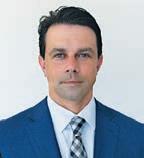

AECOM Hunt welcomes Corey Zussman as Vice President QAQC. Based in Chicago, Corey is a registered architect and three-decade AEC professional and will have national reach as a subject matter expert for AECOM Hunt. Through quality programs, seminars, educational materials, and on-site constructability reviews, Corey’s expertise helps advance the highest quality at every stage of a project.
AECOM Hunt, Chicago
AECOM Hunt welcomes Meghan McLean as Business Development Manager. Bringing more than seven years of industry experience, Meghan will be instrumental in driving AECOM Hunt’s Chicago market growth. With Vice President Kasie Mathena, Meghan will lead strategic initiatives and cultivate relationships with industry and community stakeholders. Meghan is a proud member of Professional Women in Construction’s Chicago Chapter and the Illinois Housing Council.
Wintrust Financial Corporation, Rosemont
Wintrust Financial Corp., a financial services holding company based in Rosemont, Illinois, with more than 170 locations across Illinois, Indiana, Wisconsin, and Florida is pleased to announce an appointment and a promotion. Sarah Grooms was appointed as Chief Administrative Officer, Banking Strategies at Wintrust Financial Corporation. Sarah joined Wintrust in 2001. Philip Bandle was promoted to SVP, Investments at Wintrust Investments, LLC. Philip joined Wintrust in 2009.
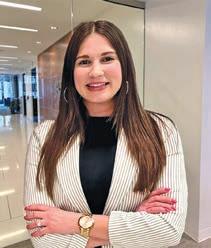




AECOM Hunt, Chicago
AECOM Hunt is pleased to welcome Ibrahim Shobowale as Project Accountant. With 14 years’ experience, Ibrahim will be responsible for managing the financial aspects of various projects within AECOM Hunt’s Central region.

Bader Rutter, Chicago
Bader Rutter names David Jordan as CEO. Jordan drives the #1 U.S. B2B agency into the future focused on transformative creative steeped in business acumen. David Jordan becomes the 4th Bader Rutter CEO in the employee-owned agency’s 50-year history. Broadly experienced on both the agency and client side, David exemplifies the firm’s guiding principle that he co-authored: “To be an idea-first culture with the deepest knowledge and strongest business acumen of any agency.”
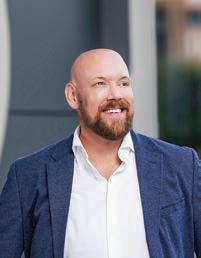







“Consumers are shifting away from dining in, we’re seeing a big uptick in drive-thru, takeaway and delivery sales,” said Sean Dunlop, equity analyst at Morningstar. “When consumers aren’t using that expensive dine-in space, you can sympathize with the argument that it makes sense to shrink the footprint, save a little bit of money upfront.”
Portillo’s last year announced it was boosting its growth goals by more than half, aiming to open at least 920 restaurants around the country in about 20 years.
It marked the first time the hot dog and Italian beef chain had updated its growth goals since going public in 2021, when it was targeting 600 restaurants in 25 years. Portillo’s at that time also increased its annual growth target to 12% to 15% annually from 10%.
Of those 920 locations, Portillo’s projected 800 would be fullscale restaurants and 120 would be pickup, walk-up or some other format. “We are accelerating our growth, but we’re doing it in a very disciplined fashion,” CEO Michael Osanloo told investors during a September 2023 investor call.
Also on Engaged’s wishlist for Portillo’s: restructuring the way the company interacts with developers. Engaged wants Portillo’s to expand using built-to-suit development models, shifting the ownership and financing of new spaces to the landlord, as is the
from recent years of financial trouble that rocked both campuses.
“Illinois is at the epicenter of this tsunami that is about to hit higher education,” said James Applegate, former executive director of the Illinois Board of Higher Education and a current committee chair at the Associated Colleges of Illinois. “I think there are ways to survive this moment, but not all the universities will.”
Applegate describes the tsunami as a demographic cliff — years of shrinking high school graduates and out-migration to out-of-state colleges — that is coming at a time when higher education costs are up and the federal aid that patched up leaky ships during the pandemic disappears.
Total undergraduate enrollment in Illinois has decreased by over 20% since 2014, equating to 144,000 fewer students, according to a 2023 report by the Illinois Board of Higher Education. But that decline has not been equally felt.
“The decline has been uneven, impacting certain institutions more severely than others,” wrote the Illinois Commission on Equitable Public University Funding, a group tasked by lawmakers with developing a potential new fund-

case for many other fast-casual restaurants. By doing that, the activist investor believes it can shave $2 million to $3 million off Portillo’s build-out expenses.
The source also said Engaged believes Portillo’s must increase brand awareness outside the Chicago area. The investor sees Portillo’s as Chicago’s equivalent to New York’s Shake Shack and California’s In-N-Out Burger, but folks outside of the city don’t necessar-
ing model for the state colleges. In its report, released earlier this year, the commission found that between 2017-18 and 202122, Chicago State University lost 31% of its student headcount and Northeastern Illinois University lost 40% — the two public schools that showed some of the earliest signs of trouble. Meanwhile, the University of Illinois Chicago and University of Illinois Urbana-Champaign experienced 11% and 15% increases in student headcount, respectively.
NIU has also experienced a prolonged drop in enrollment. NIU’s total student enrollment remained relatively flat in 2023 at 15,504, compared with 15,649 in fall 2022, a difference of less than 1%. But those figures are far below its peak in 2006, when it reported a total student enrollment of 25,313 for the fall. Meanwhile, WIU’s enrollment has dropped by more than 50% since 2006.
Sen. Chapin Rose, R-Champaign, whose district includes U of I’s Urbana-Champaign, said the public universities are now “cannibalizing” each other over competition for students at the expense of the smaller, more regional schools.
“This is now a zero-sum game as the number of people demanding higher education is
ily make that connection. The firm will push Portillo’s to open in high foot-traffic satellite locations like airports and stadiums, as it has already done, to increase brand awareness.
Notably, the source said Engaged is not currently pursuing any management changes. Added Dunlop: “That’s not what they are known for necessarily.”
In a filing with the U.S. Securities & Exchange Commission, the
firm disclosed it had been in discussions with management about “potential steps to unlock the intrinsic value” of the business. Those conversations included potential changes to the company’s board of directors and a possible sale of the business, according to the filing.
The Aug. 15 filing made Engaged the largest single holder of Portillo’s stock, with a 9.9% stake. Berkshire Partners, a Boston-based
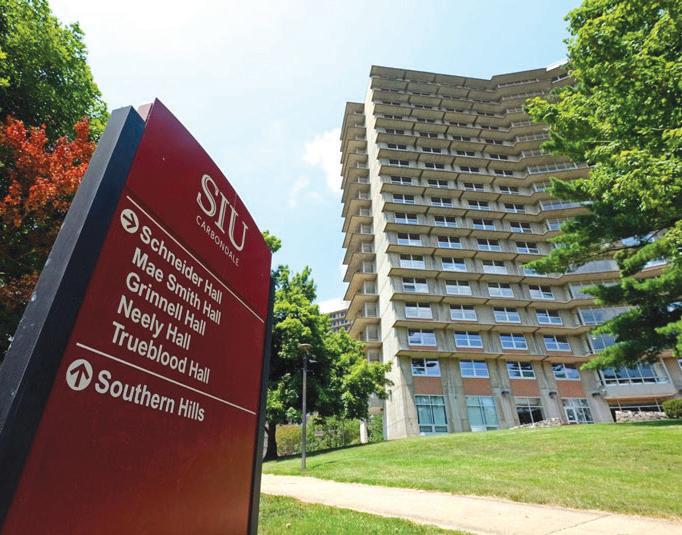
continuing to decline,” he said.
The Illinois Commission on Equitable Public University Funding found that to fully fund Illinois public colleges the state would need to allocate an additional $1.4 billion to the schools, which received $2.5 billion in fiscal year 2024. Gov. J.B. Pritzker has increased the funding to schools, but nearly two decades of underfunding, including a budget impasse that began in 2015 and lasted over 700 days, have taken their toll.
“Gov. Pritzker has tried, but it’s like throwing a little bit of dirt in
private-equity firm, is next on the list with a 9.58% stake. Other major holders include Vanguard Group, BlackRock and Citadel Advisors.
In a statement to Crain’s, a Portillo’s spokesperson wrote, “Portillo’s regularly engages with its shareholders to understand their perspectives and we have spoken with Engaged Capital. Our Board and management team will continue to take actions and make decisions that are in the best interests of our shareholders.” Portillo’s did not comment specifically on Engaged eying smaller storefronts.
The initial news of Engaged Capital’s action was bound to have rattled Portillo’s C-suite, according to Chicago restaurant industry consultant Aaron Allen. ‘Terrified’ restaurant owners
“Restaurants are just terrified of these activist investors,” Allen told Crain’s on Aug. 16. “This is part of a broader trend. There’s been a lot more of this recently. They are really terrifying restaurant owners. I’ve talked to some CEOs who are even taking early retirement because they are scared of this pressure.”
Among the factors that could be driving activist interest in Portillo’s: Shares of its stock have declined roughly 70% since the restaurant operator went public in late 2021. Portillo’s now trades at a more than 50% discount to such fast-casual chains as Chipotle and Shake Shack.
Engaged last year forced changes at Shake Shack after threatening to launch a proxy battle for board seats at the New Yorkbased burger chain.
about that big of a deficit?” Kerry Ferris, a member of the tenuretrack faculty union at NIU who previously served as the unit president, told Crain’s as the school stares down a $31.8 million deficit. “There is some anxiety among the faculty and probably also among the students about how the school will reduce that deficit.”
a gaping hole,” said Applegate. “There was a billion dollars gone from higher education during the budget impasse. That’s a billion over that period that will never come back.”
As colleges attempt to balance the budget, faculty and staff are among the first casualties. WIU has already laid off 124 faculty and staff, and fears are growing at NIU that layoffs may come despite assurances from the administration that they won’t.
“Who is not going to be scared
Applegate warns there is no quick fix or silver bullet for the sector, which is swimming against increasingly hostile currents. Increased funding from Springfield would help, but next year’s budget is expected to be tight. Applegate suggests targeting different demographics, such as adult learners, could help get people back into seats. He added that increased retention rates at these colleges, which he says are only graduating around 50% of their students at some schools, could also help boost finances.
Rose said schools need to focus on what they do best in order to stop the bleeding.
“What I would urge everybody to do is refocus on the demand equation of this program and say, ‘If we’re producing a product that people want, we would have students in our seats,’ ” said Rose. “We need to tap into new markets and offer a competitive product that’s affordable or students will continue to go out of state.”
Heavy hitters including JPMorgan Chase and Citibank say the new rule, which is unique to the state, will ‘throw well-operating, payment-card systems into chaos’
By John Pletz
Trade groups representing banks and credit unions are suing the state of Illinois over a new law that would exempt state and local taxes and tips from the interchange fees charged by credit card processors.
Bankers were surprised by the law, which emerged at the 11th hour of this year’s budget session in Springfield. Lawmakers decided to reduce the interchange fees, largely paid by merchants, on credit and debit card transactions as a way to soften the blow of a new law that would generate $100 million in state revenue by reducing the amount of money paid to merchants for collecting state and local sales taxes.
Bankers, credit card companies and airlines such as United (who rely heavily on the profits they make from credit card partner-
From Page 3
day,” Cahillane said. “If someone comes and makes a compelling offer, then you have to listen.”
The deal is subject to closing conditions, and could still face scrutiny from federal regulators that have looked more closely at conglomerate mergers in recent years.
If the deal closes, Kellanova will be integrated into Mars Snacking and headquartered in Chicago. Andrew Clarke, global president of Mars Snacking, will lead the combined company. The short-lived Kellanova name will go away, but the brand names well known to consumers will remain.
Cahillane was not made available for comment to Crain’s, but has said in other interviews he is
ships) opposed the law from the outset.
Now, they’ve gone to federal court to stop the law, which is the first of its kind in the nation.
Among the plaintiffs are the American Bankers Association, the Illinois Bankers Association, America’s Credit Unions and the Illinois Credit Union League. They are bringing the case on behalf of some of the largest credit card processors and issuers, such as JPMorgan Chase, Citibank, Wells Fargo, Mastercard and Visa, as well as smaller community banks and credit unions.
They claim that Illinois’ new law runs afoul of various federal banking regulations by unfairly usurping powers of those regulators, which set standards for banks, home lenders and credit unions.
They also say the Illinois law would put financial institutions here at a
focused on running Kellanova and supporting a successful completion of the transaction. Documents filed with the U.S. Securities & Exchange Commission say “a joint integration of team leaders” from both companies will determine how best to combine Kellanova with Mars Snacking.
Cahillane proved he can deliver value for shareholders, said Harry Kraemer, former CEO of Baxter International and a professor at Northwestern University’s Kellogg School of Management.
“I’m sure he will get approached to run other companies,” he said. “It’s something he does very well.”
In the long term, the deal will likely prove beneficial for Chicago as a hub for food companies, experts say. It also continues privately owned Mars’ tradition of buying up such storied food firms based in the city.
disadvantage to those in other states, which violates federal law.
They claim that complying with the new law “would massively disrupt the operations” of financial institutions and “throw well-operating, payment-card systems into chaos.” The plaintiffs question whether technology could be created to allow credit card processors to exempt taxes, fees and tips by the time the law takes effect next July. If it can be done, they say, the costs could run into the tens of millions for some credit card issuers.
The banking groups are seeking a temporary injunction to prevent the law from going into effect.
Bankers and credit card companies say the 2% charge on transactions, known as an “interchange fee,” offsets the costs and risks associated with default and fraudulent transactions. It also helps cover the costs of providing customer
In 2008, McLean, Va.-based Mars paid $23 billion — or $80 per share — for gum maker Wm. Wrigley Jr. Co. Subsidiary candy maker Mars Wrigley remains headquartered in the city, with its Global Innovation Center on Goose Island, which employed about 600 people as of last summer, half of whom were in research and development.
The $14 billion Kellanova was headquartered in Chicago postsplit, located at an office it already leased at 412 N. Wells St. That space was once RxBar’s headquarters, which Kellogg bought in 2017. Pre-split, the company had about 300 employees in the Chicago area, including those that worked at an office in Naperville. Cahillane, who remained CEO of Kellanova, told Crain’s last year the company would not ask employees to relocate from Kellogg’s
service, system operations, customer data protection, fund transfers, card processing and production, as well as rewards programs, they say.
“This lawsuit was expected, and it’s no surprise credit card companies would do all they can to undermine this law and maintain their ability to unilaterally impose exorbitant processing fees on workers’ tips and taxes on consumer purchases,” Rob Karr, CEO of the Illinois Retail Merchants Association, said of the lawsuit. “We once again applaud Gov. J.B. Pritzker and legislators for their support of the Interchange Fee Prohibition Act.”
The IRMA says financial institutions are overstating the burden. They have the capabilities to separate taxes and tips from interchange fees, saying they're already prohibited from charging such fees on WIC or SNAP purchases at retail.
longtime home in Battle Creek, Mich.
Mars and Kellanova have said Battle Creek will remain “a core location for the combined organization,” according to an SEC filing detailing the deal.
Even so, the jobs that will be eliminated post-merger will likely be those based in Battle Creek, said Jeff Pehler, partner at business management consulting firm West Monroe. Typically, overlapping jobs in areas such as human resources or information technology face the chopping block after such deals.
If Chicago-based jobs do end up being cut, other food companies will benefit from scooping up that talent, he said.
“In the short term, it’s going to benefit Chicago,” he said. “In the long term, it’s going to benefit Chicago even more broadly.”
or editor@chicagobusiness.com
SENIOR REPORTERS
Ally Marotti, John Pletz, Dennis Rodkin REPORTERS
Katherine Davis, Brandon Dupré, Danny Ecker, Jack grieve, Rachel Herzog, Justin Laurence, steven R. strahler, Mark Weinraub
ADVERTISING
Sales director Christine Rozmanich (312) 649-5446 or crozmanich@crain.com
Classified
CRAIN’S
(313)
or kbull@crain.com
Crain’s Content Studio manager Jordan Dziura Custom content coordinator Allison Russotto
PRODUCTION
Vice president, product Kevin skaggs
Product manager tim simpson
Premedia director simone Pryce
CUSTOMER SERVICE (877) 812-1590
owning manufactured home parks. Some of the biggest privateequity owners of factory-built home communities in the Chicago area include Stockbridge Capital Group, Apollo Global Management and Calzada Capital Partners.
Private equity’s growing influence in the sector has raised concern among watchdog groups that outside investors are using the opportunity to jack up rents on low-income residents, further exacerbating the affordable housing problem. In many manufactured housing communities, also known as mobile home parks, tenants own the homes themselves but pay rent on the lots, and, despite the “mobile” moniker, often have little ability to move.
PESP launched a new tool in June tracking the ownership of manufactured housing projects by private-equity firms and hedge funds, which shows Michigan has the second-highest number of manufactured housing parks owned by private equity in the country at 113, or 10% of the state’s total.
Lawmakers in Michigan concerned about outside investment have sought to put rent caps on lots, but the industry has pushed back, leaving the future of the legislation uncertain.
“For private equity, when they buy an asset, it is not because it is currently profitable,” said Jordan Ash, housing director at PESP, which is critical of private-equity activity in essential industries.
“It is because they consider it undervalued and that they think they can make even more money from it,” he said. “They see the po-
tential then to increase the rents and increase fees a lot more and to bring even more money.”
Rents at manufactured housing communities have indeed been rising. A report by real estate firm Northmarq showed average rents ended the first quarter of 2024 at $685 per month, 7.5% higher than a year ago.
The cost of the homes themselves are also surging as demand increases, with prices for factorybuilt homes jumping 110.1% in Illinois between 2017 and 2022, according to a study by LendingTree, an online loan lead generator and mortgage broker.
The U.S. government is taking notice. The Department of Housing & Urban Development in June launched a program allowing certain entities such as residentowned communities, state and local governments and nonprofits to access financing to buy or im-
prove existing manufactured housing parks.
“This tool provides an alternative to purchase of these communities by private equity funds and similar financial interests, whose track record reportedly includes unaffordable rent increases, failure to invest in community infrastructure, and regulations that don’t respect the community’s culture,” the department said in a release touting the program.
Private-equity firms, meanwhile, see profit potential in the industry despite the growing pushback. Monroe Capital, which is providing financing to owners rather than buying manufactured home parks outright, plans to invest further in the space.
“Given the very large cost increases in housing and inflation and building costs, these are very necessary parts of the housing ecosystem,” Asher said.








chicagosfoodbank.org/crains

